After the visit to the Mae Kachan Hot Spring, the one-day trip I took on the second full day in Chiang Mai, northern Thailand, took me to the city of Chiang Rai, which is located approximately 190 km northeast of Chiang Mai.
Let me first mention that Chiang Rai was founded in 1262 by the same King Mangrai who founded Chiang Mai. Moreover, this city got its name directly after the king – “Chiang” means city and “Rai” is the second part of the king’s name.
However, on this trip, we didn’t delve into Chiang Rai’s past, but rather we focused on relatively modern things, such as a couple of temples from the late 20th century. First, we arrived at a temple located about ten kilometres before reaching the city itself (from the direction of Chiang Mai). This temple is called Wat Rong Khun, more commonly known as the White Temple. When you visit here, it becomes quite clear where this alternative name comes from.
 Wat Rong Khun or the White Temple
Wat Rong Khun or the White Temple
Earlier, at this location, there used to be the original Wat Rong Khun temple, but by the end of the 20th century, it was in quite a poor condition and there were no funds for its renovation. For this reason, the renowned Thai visual artist, primarily a painter, Chalermchai Kositpipat, decided to rebuild the temple and, furthermore, finance the entire project with his own money. His idea was to create the most beautiful temple in the world, showcasing the grandeur of contemporary Thai Buddhist art. In addition, it has been envisaged for this place to be a centre of learning and meditation. Kositpipat himself views the temple as his offering to the Buddha and believes that this project has secured him immortality. The construction of the temple began in 1997 and, taking into consideration the way it was conceived, it is estimated that it will not be completed during the lifetime of its visionary creator.
At the same time, although the project includes buildings for accommodating monks, the temple essentially functions as an art museum and everything should be viewed in that light.
The main structure is the ubosot that can be seen in the middle on the previous photo and here it is again in the several photos that follow.
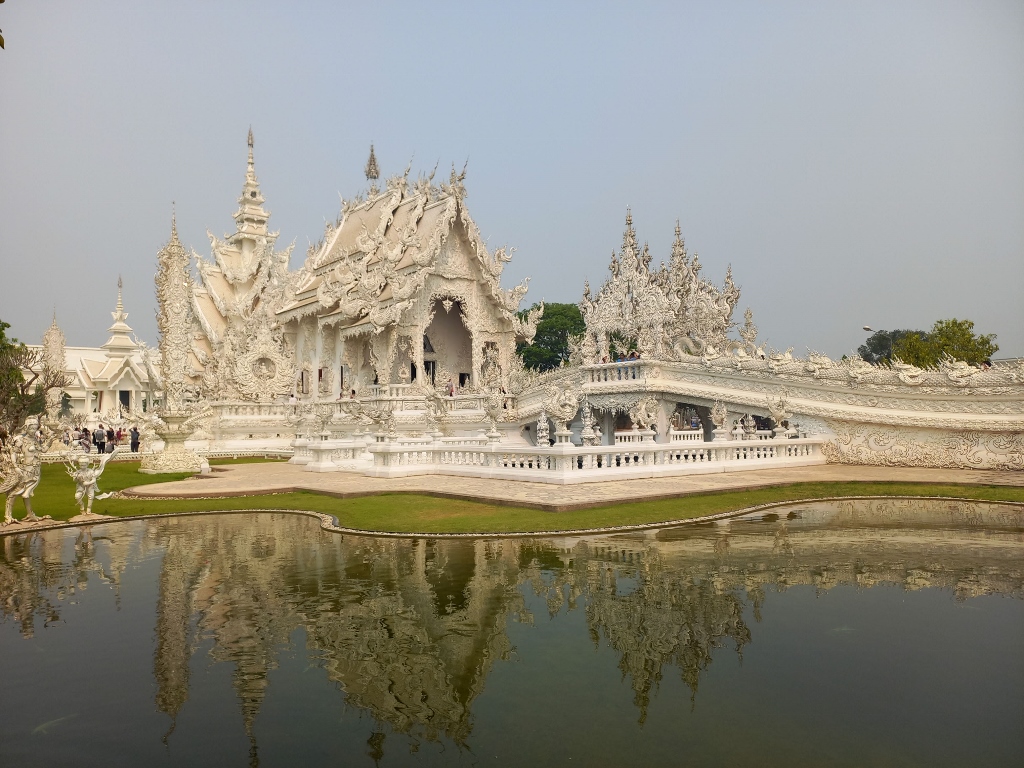 Wat Rong Khun, the ubosot
Wat Rong Khun, the ubosot
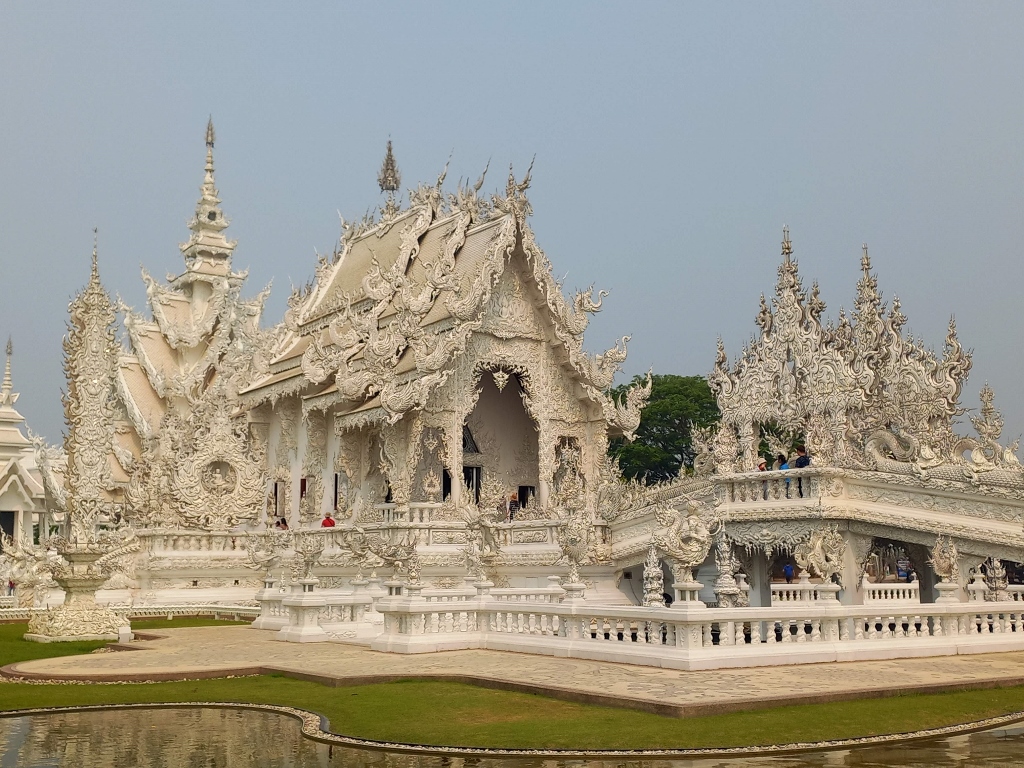 Wat Rong Khun, the ubosot
Wat Rong Khun, the ubosot
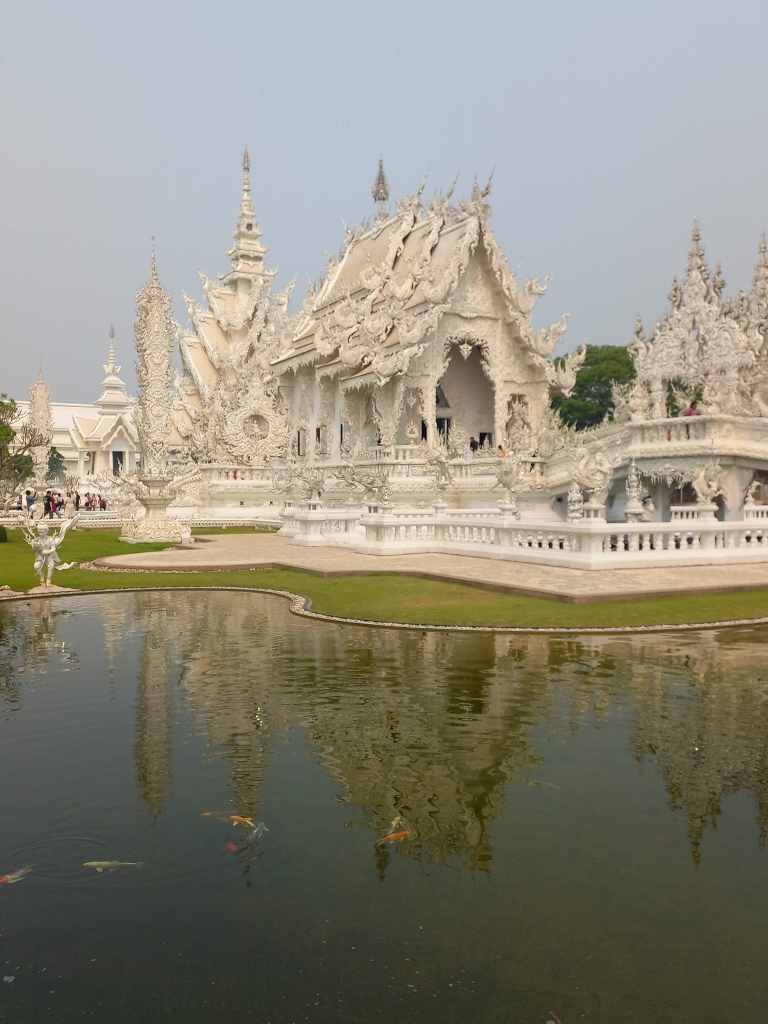 Wat Rong Khun, the ubosot
Wat Rong Khun, the ubosot
One should bear in mind that due to weather conditions (certain haziness caused by high humidity), the temple may appear more beige. However, when the weather is clear and the sky is blue, the temple dazzles with its impressive white colour. Just look it up on the internet or visit during a different time of the year. Admittedly, some parts might appear snow-white in my photos, but that’s usually due to a specific angle at which the light falls.
Otherwise, this place is teeming with an incredible array of interesting and picturesque details. However, since this is still a temple, not an amusement park, I’m confident that all these details carry their religious or spiritual symbolism.
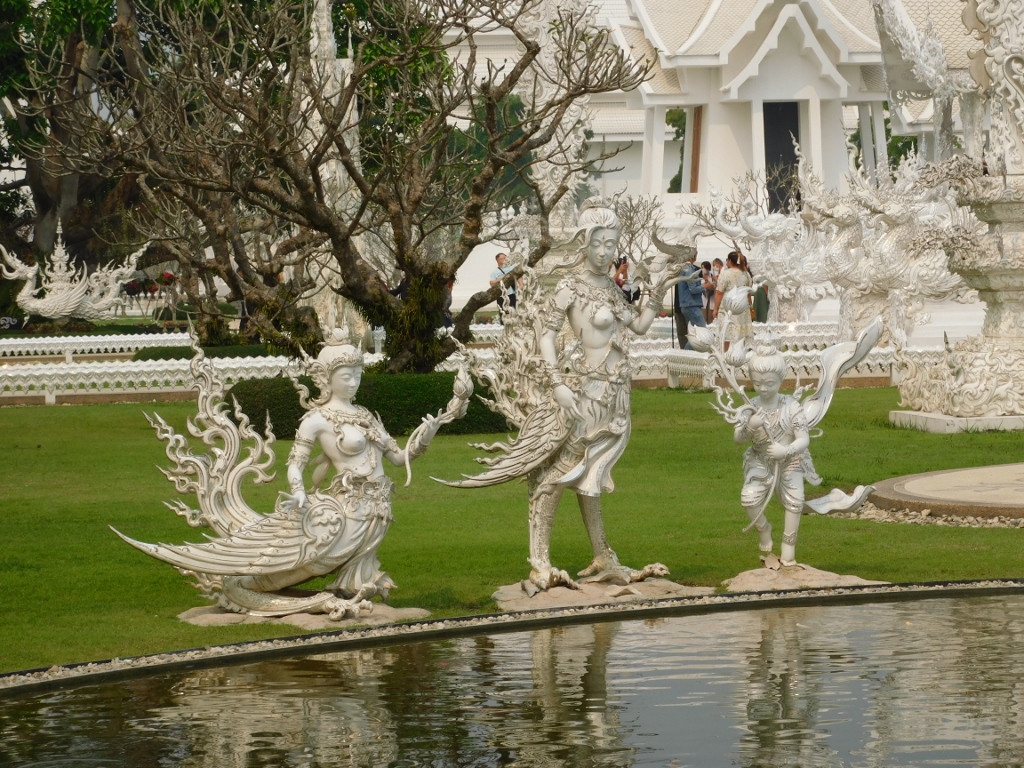 Wat Rong Khun, a detail
Wat Rong Khun, a detail
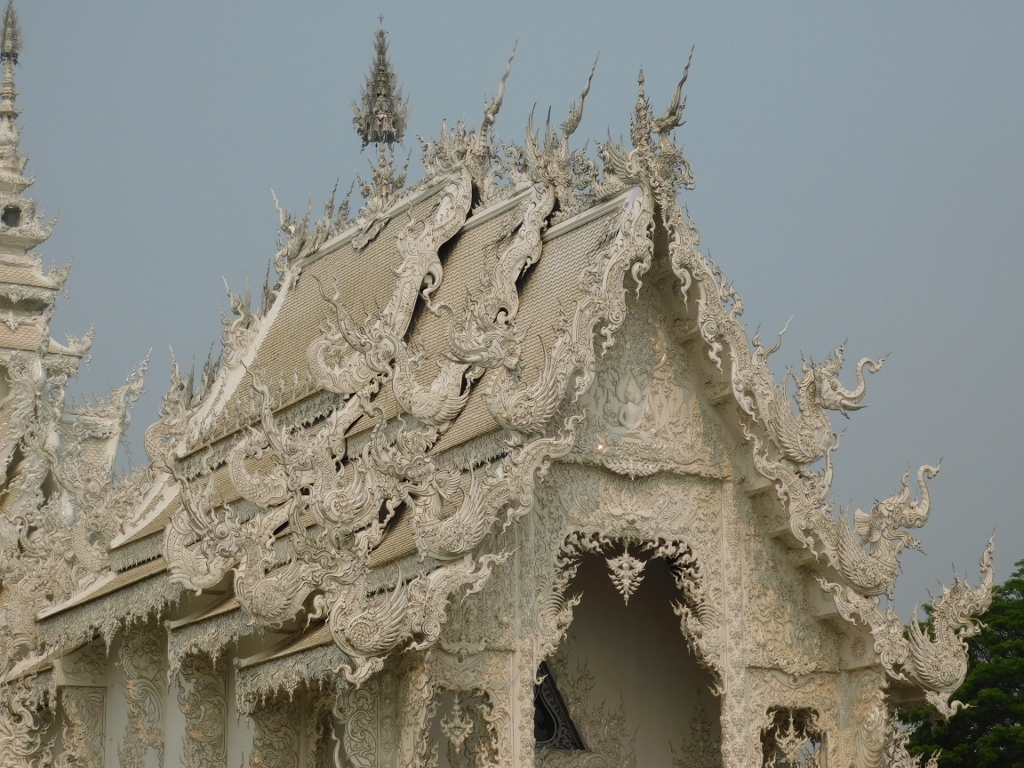 Wat Rong Khun, the ubosot, a detail
Wat Rong Khun, the ubosot, a detail
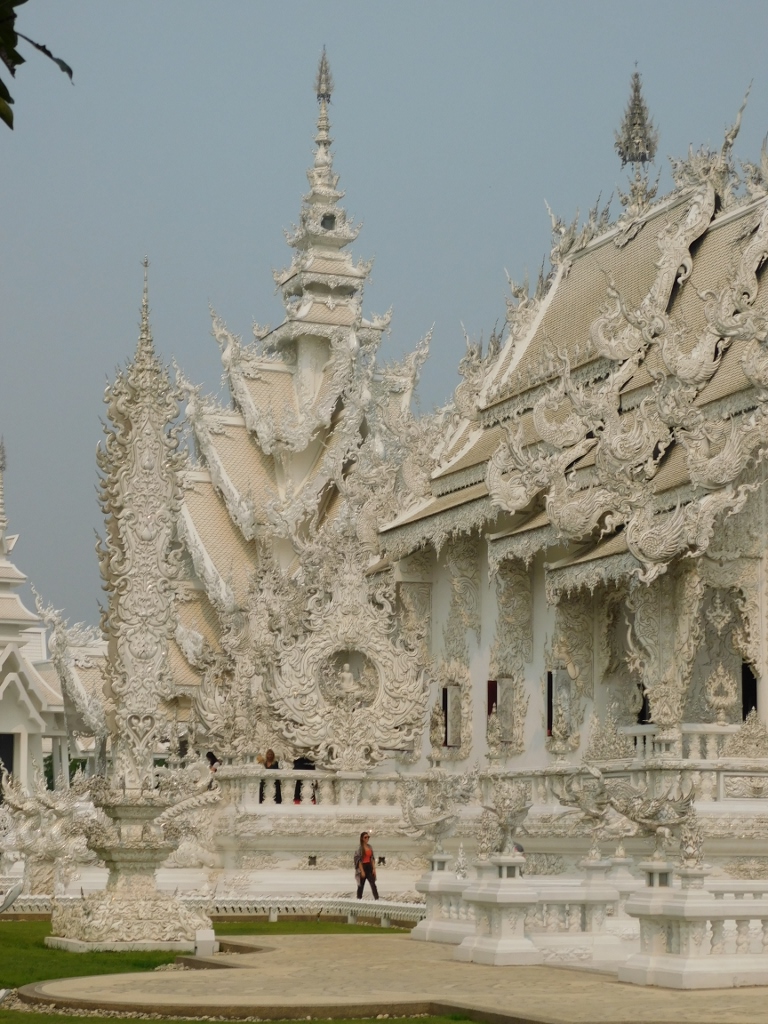 Wat Rong Khun, the ubosot, a detail
Wat Rong Khun, the ubosot, a detail
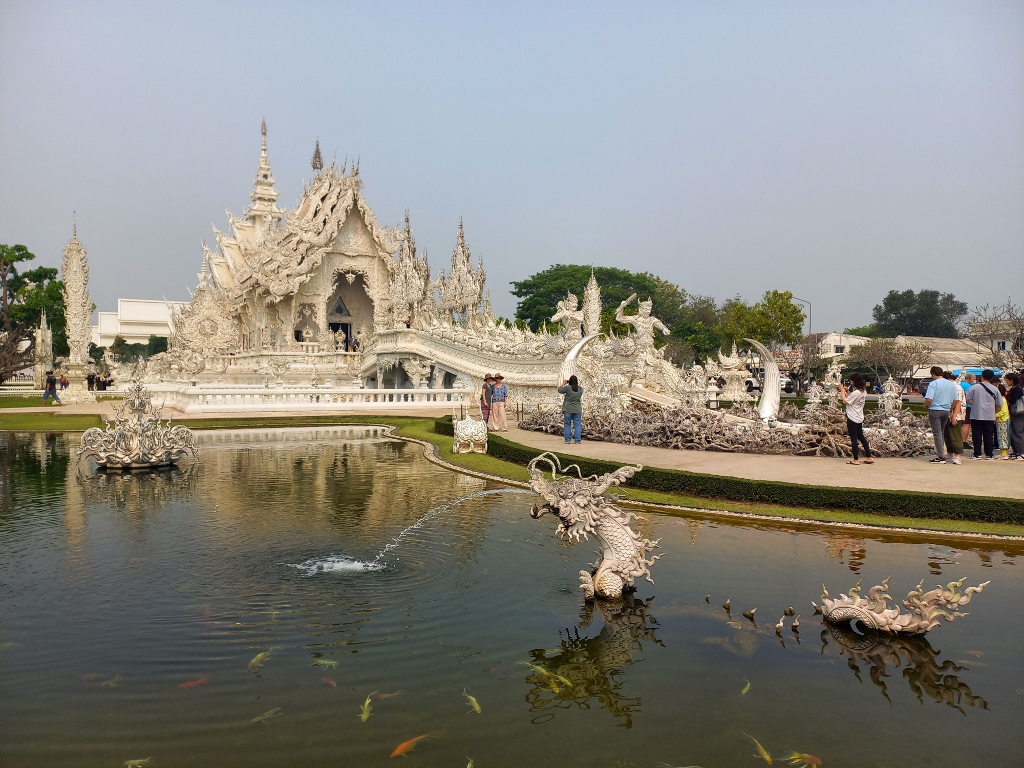 Wat Rong Khun, the ubosot
Wat Rong Khun, the ubosot
Since photography inside the ubosot is not allowed, I decided to balance my visit by capturing every impressive detail I encountered from the outside. The visit to the ubosot follows a designated path and a sort of queue is formed as people proceed straight, pass through the ubosot and then exit from the back.
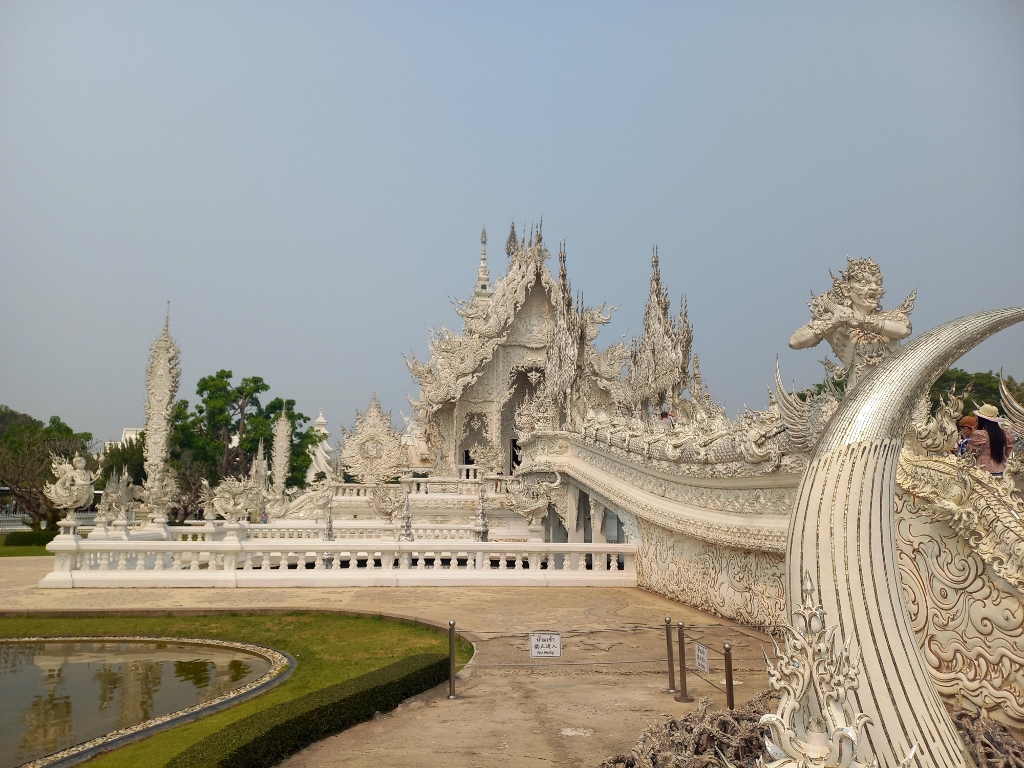 Wat Rong Khun, the ubosot
Wat Rong Khun, the ubosot
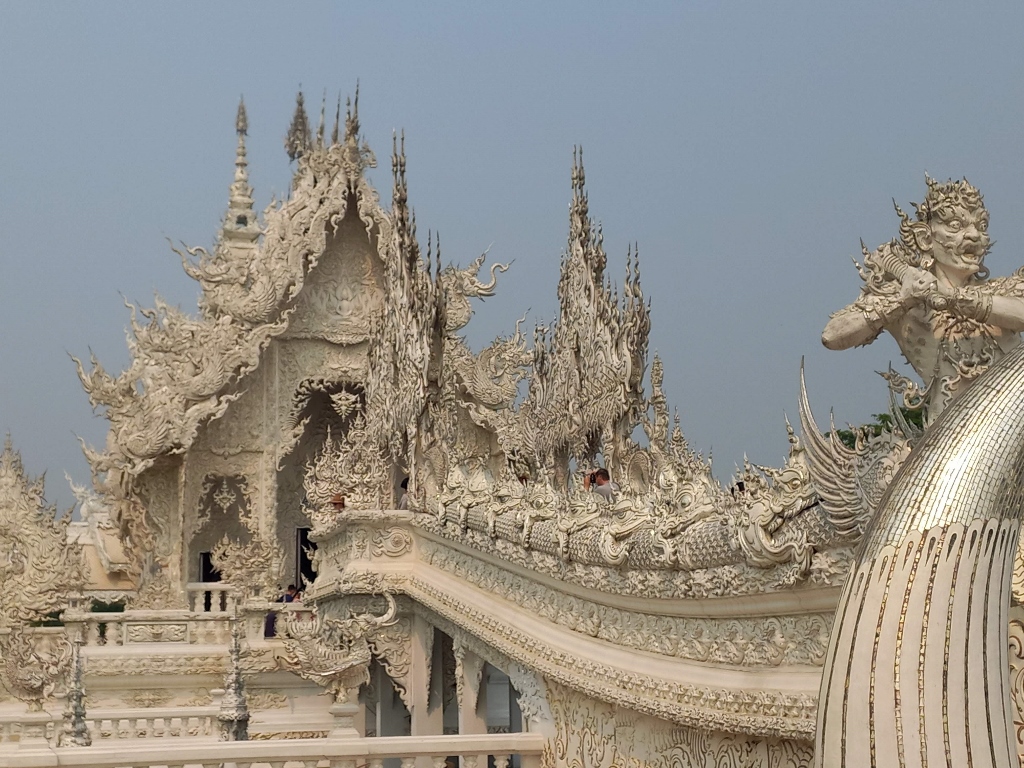 Wat Rong Khun, the ubosot
Wat Rong Khun, the ubosot
At the beginning of the path, to the left and right, hundreds of hands reaching upwards can be seen, symbolising unrestrained desire or, as one might say, “more, and more, and more.” This serves as a mantra for the contemporary, unbridled commercialised world we live in. The idea conveyed here through the path leading straight over a little bridge across the pond is that happiness can be achieved only if we resist temptations and greed, while restraining our desires.
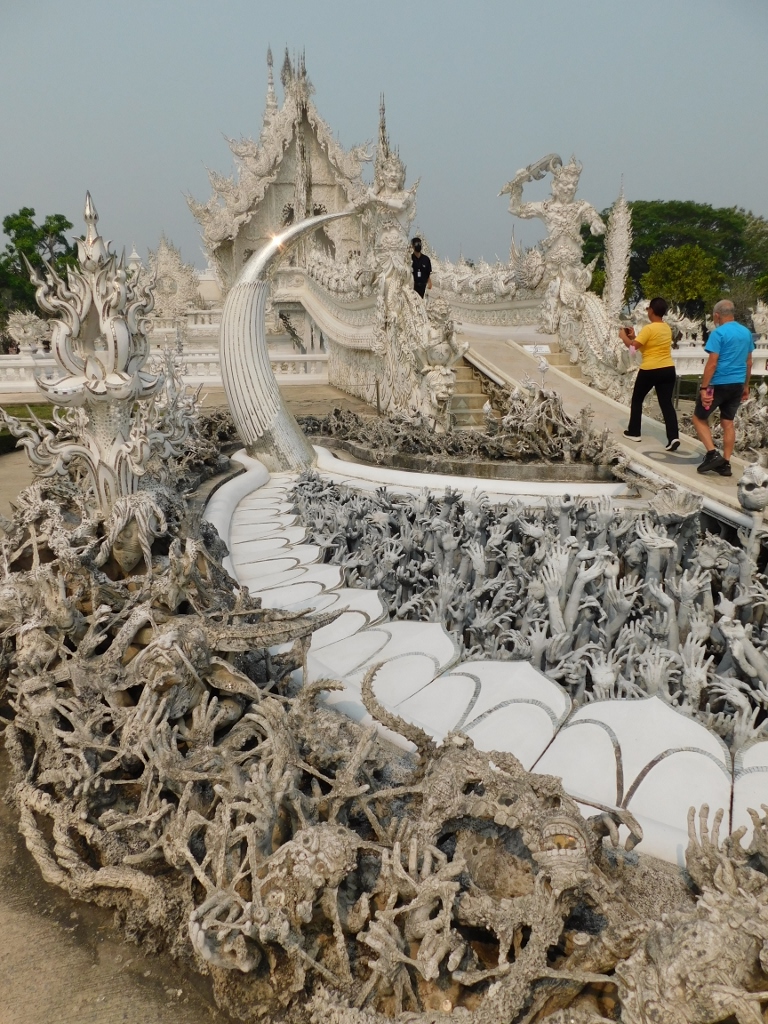 Wat Rong Khun, the ubosot, a detail
Wat Rong Khun, the ubosot, a detail
At the entrance to the bridge, two impressive figures from Buddhist mythology stand tall, but before them there are also less powerful, yet undoubtedly impressive smaller-sized figures.
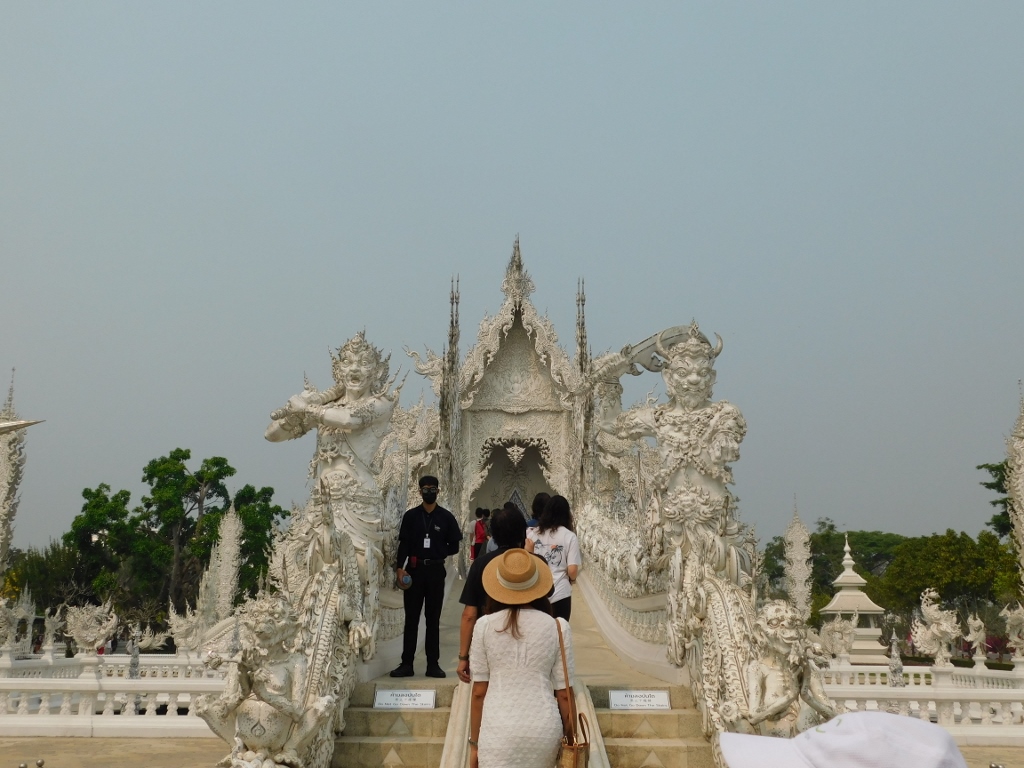 Wat Rong Khun, the ubosot, a detail
Wat Rong Khun, the ubosot, a detail
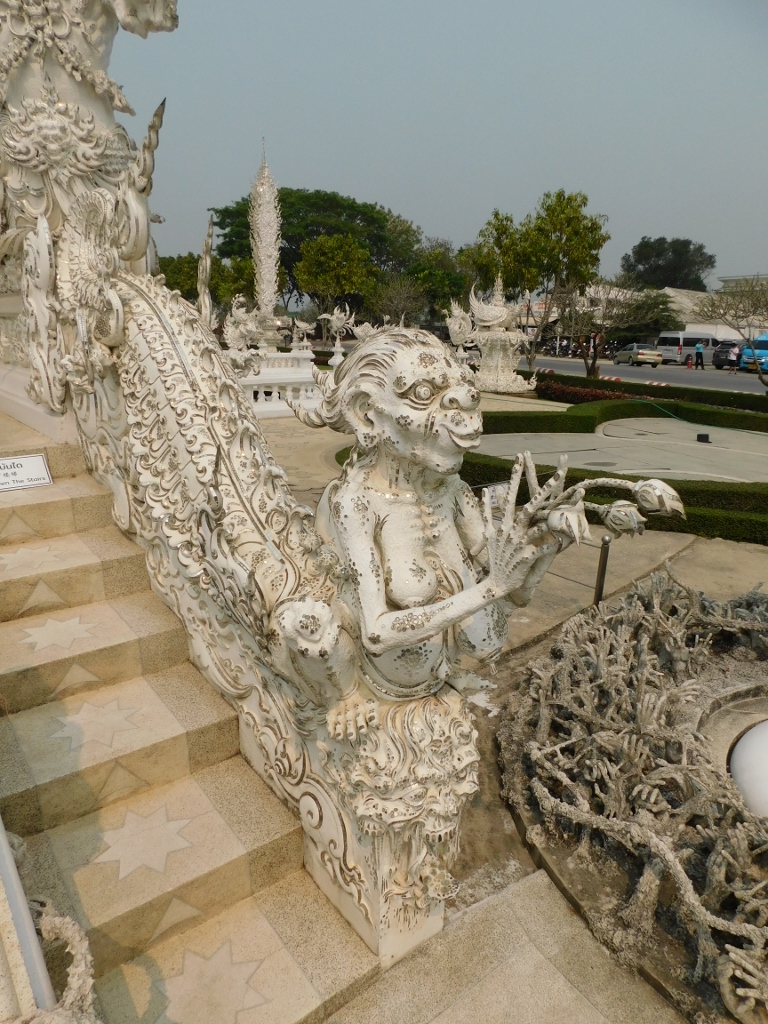 Wat Rong Khun, the ubosot, a detail
Wat Rong Khun, the ubosot, a detail
Then, crossing the bridge, you reach the “Gate of Heaven” guarded by two mythological guardians. I was so impressed by the richness of details that I didn’t know which way to look first. Fortunately, the path just continued straight ahead.
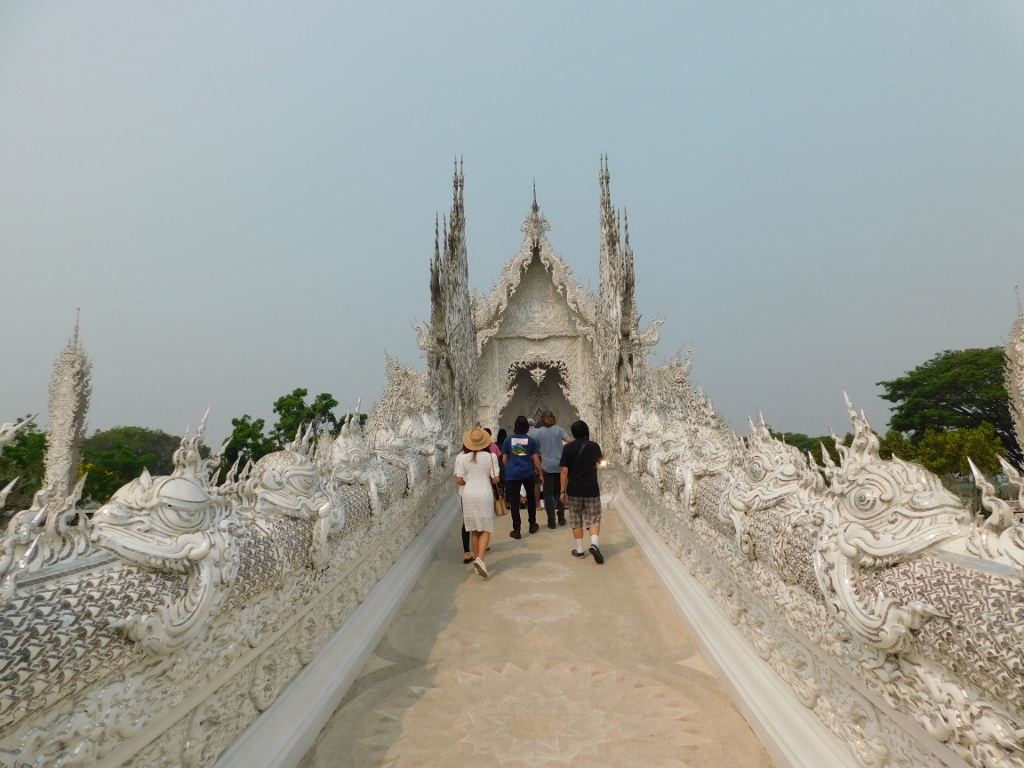 Wat Rong Khun, the ubosot, a detail
Wat Rong Khun, the ubosot, a detail
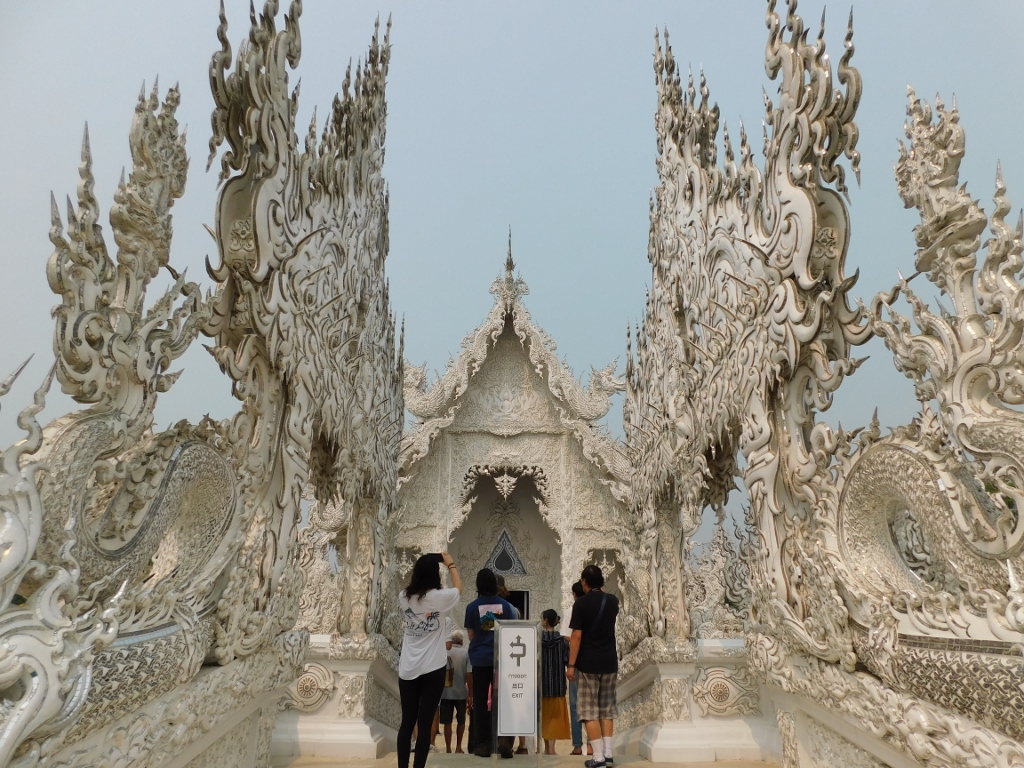 Wat Rong Khun, the ubosot, a detail
Wat Rong Khun, the ubosot, a detail
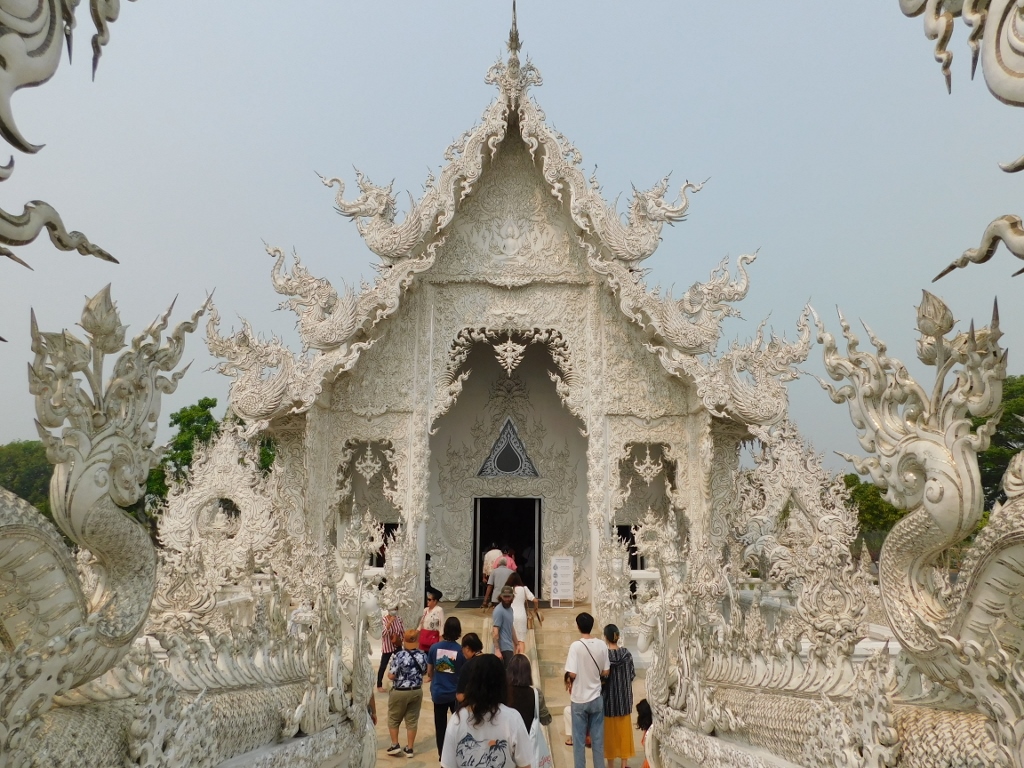 Wat Rong Khun, the ubosot, a detail
Wat Rong Khun, the ubosot, a detail
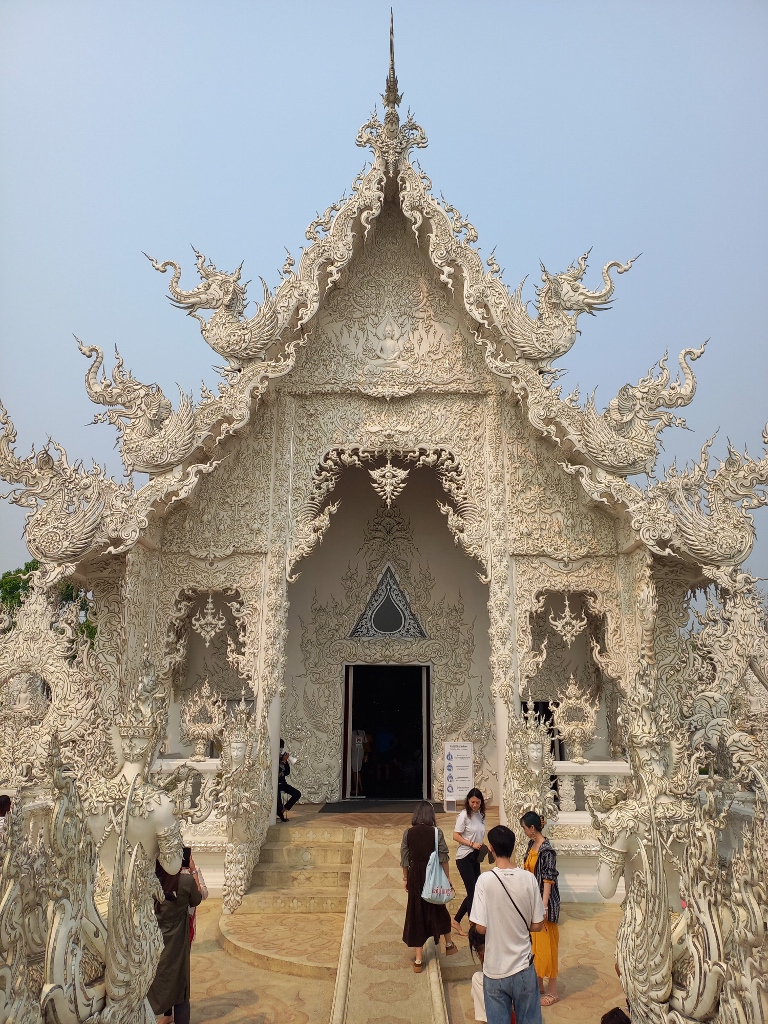 Wat Rong Khun, the ubosot, a detail
Wat Rong Khun, the ubosot, a detail
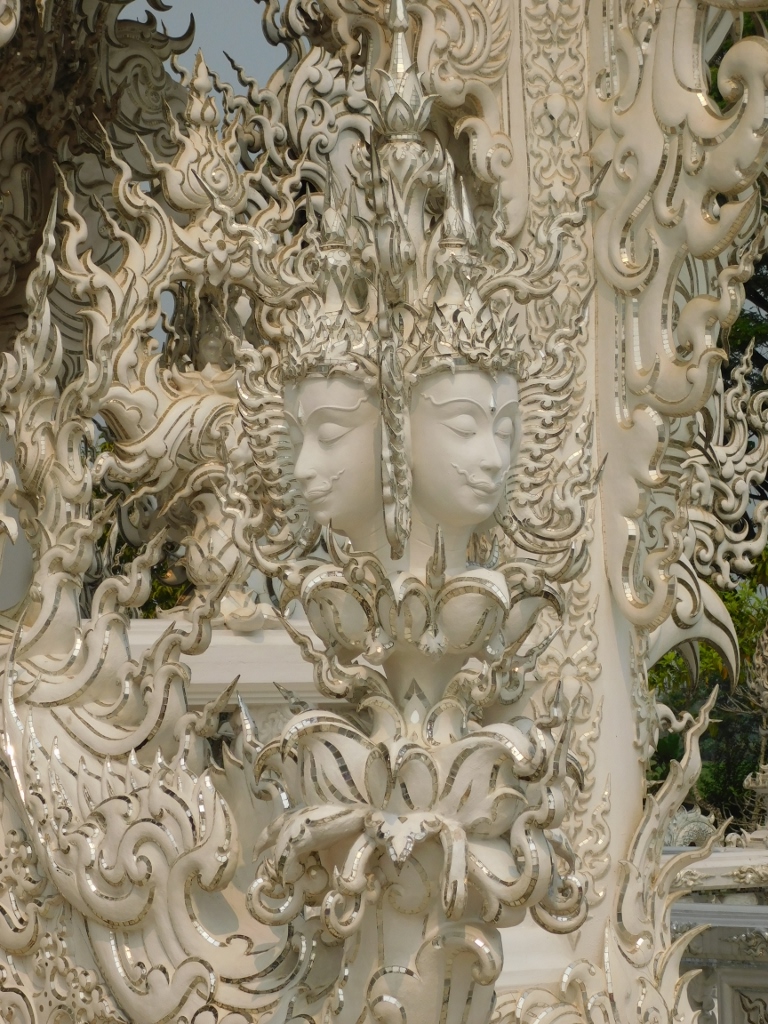 Wat Rong Khun, the ubosot, a detail
Wat Rong Khun, the ubosot, a detail
When I passed through the ubosot and reached another structure connected to it by an open passage, the rich decoration continued. I don’t have any additional information to add here, but the impressions were truly incredible.
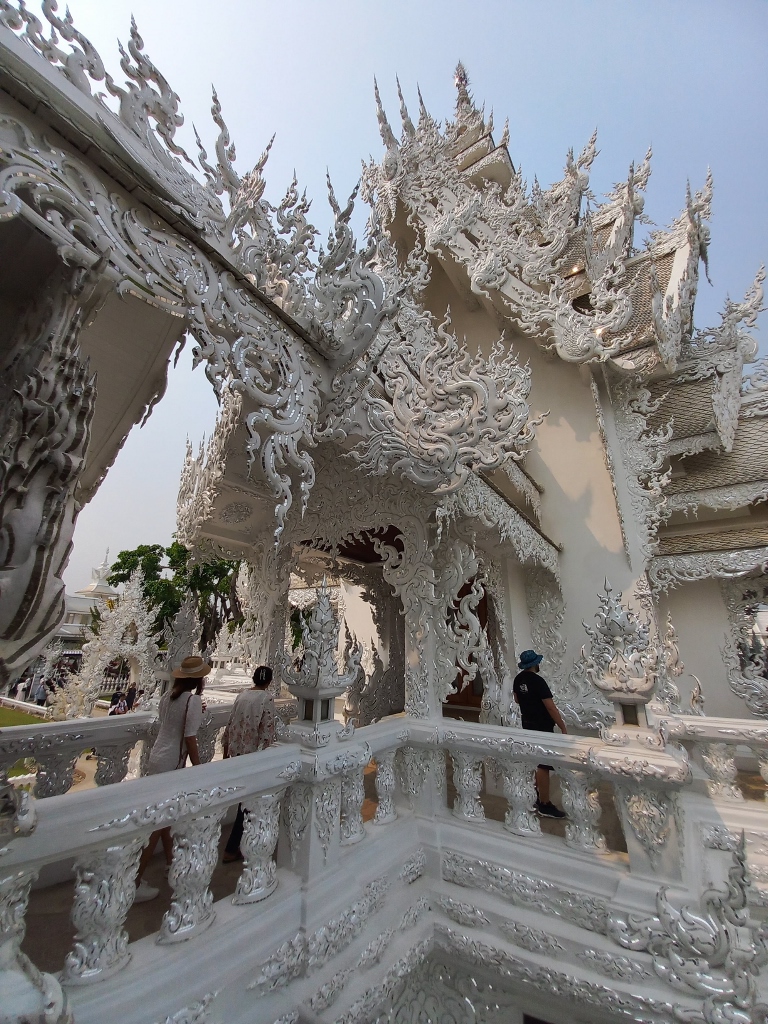 Wat Rong Khun, the ubosot, a detail
Wat Rong Khun, the ubosot, a detail
 Wat Rong Khun, the ubosot, a detail
Wat Rong Khun, the ubosot, a detail
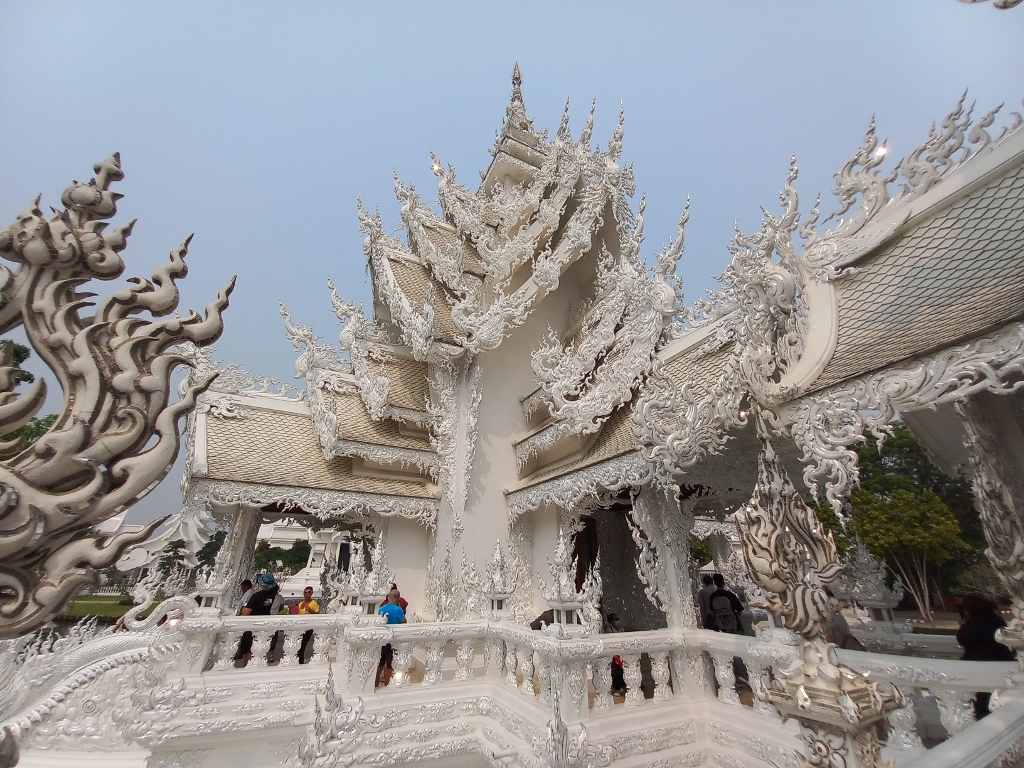 Wat Rong Khun, the ubosot, a detail
Wat Rong Khun, the ubosot, a detail
Upon closer inspection, some details reveal how a part of the effect is achieved – the entire structure is covered not only with various surfaces but also with fragments of glass, whose reflection further emphasises the whiteness.
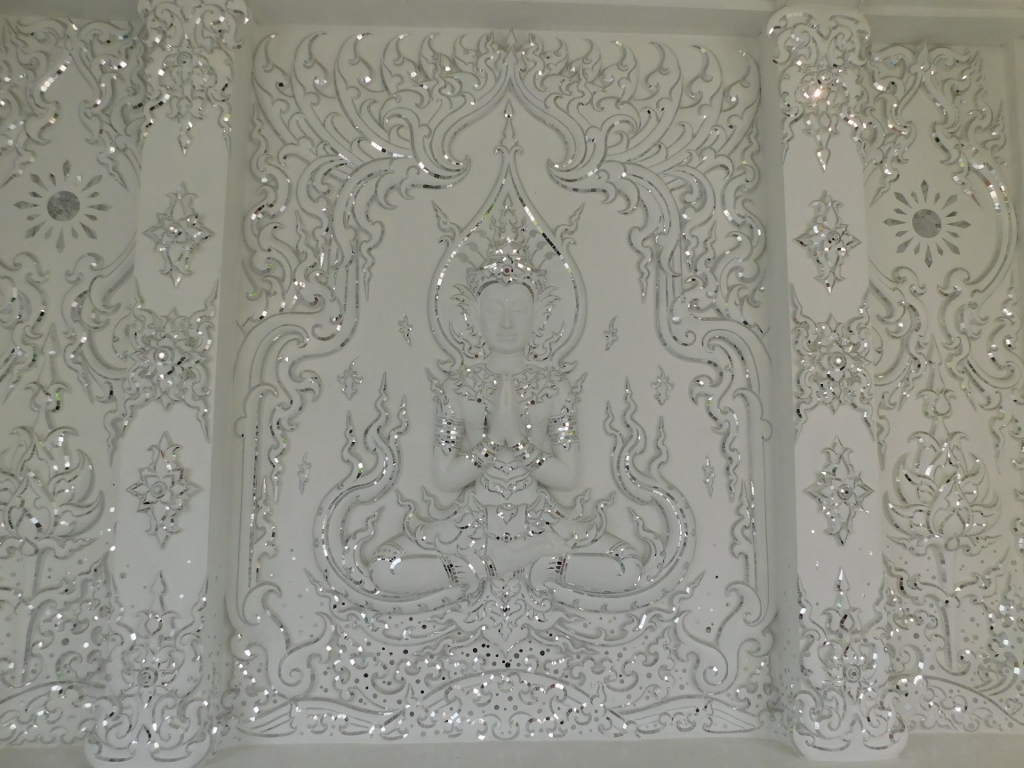 Wat Rong Khun, the ubosot, a detail
Wat Rong Khun, the ubosot, a detail
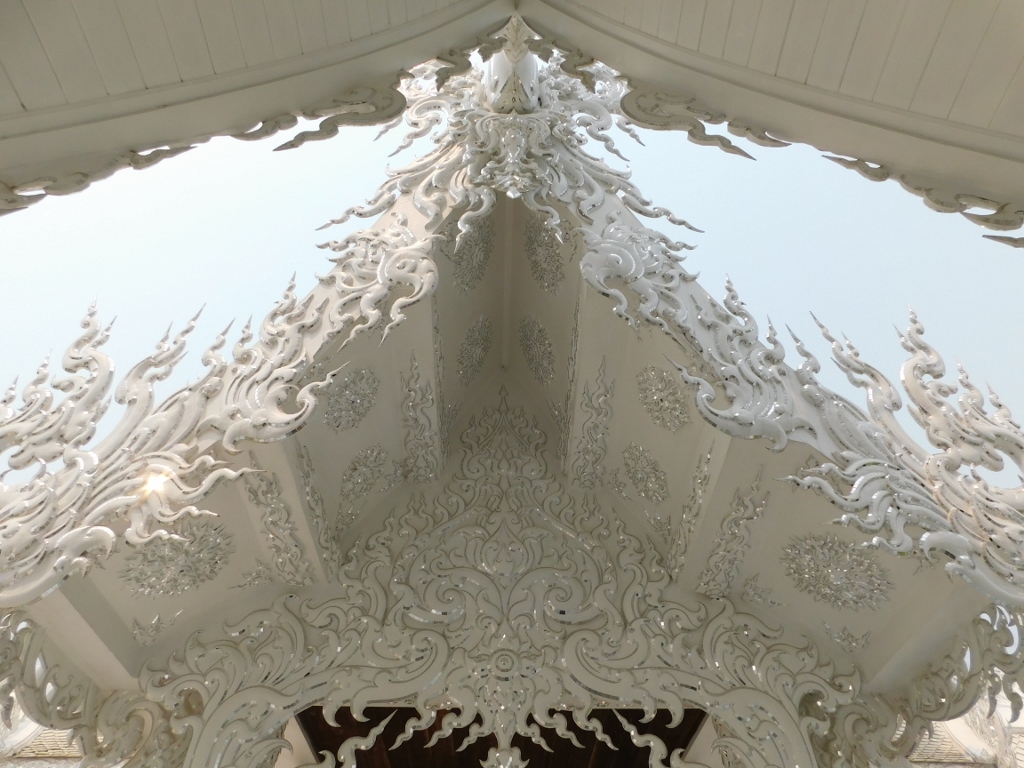 Wat Rong Khun, the ubosot, a detail
Wat Rong Khun, the ubosot, a detail
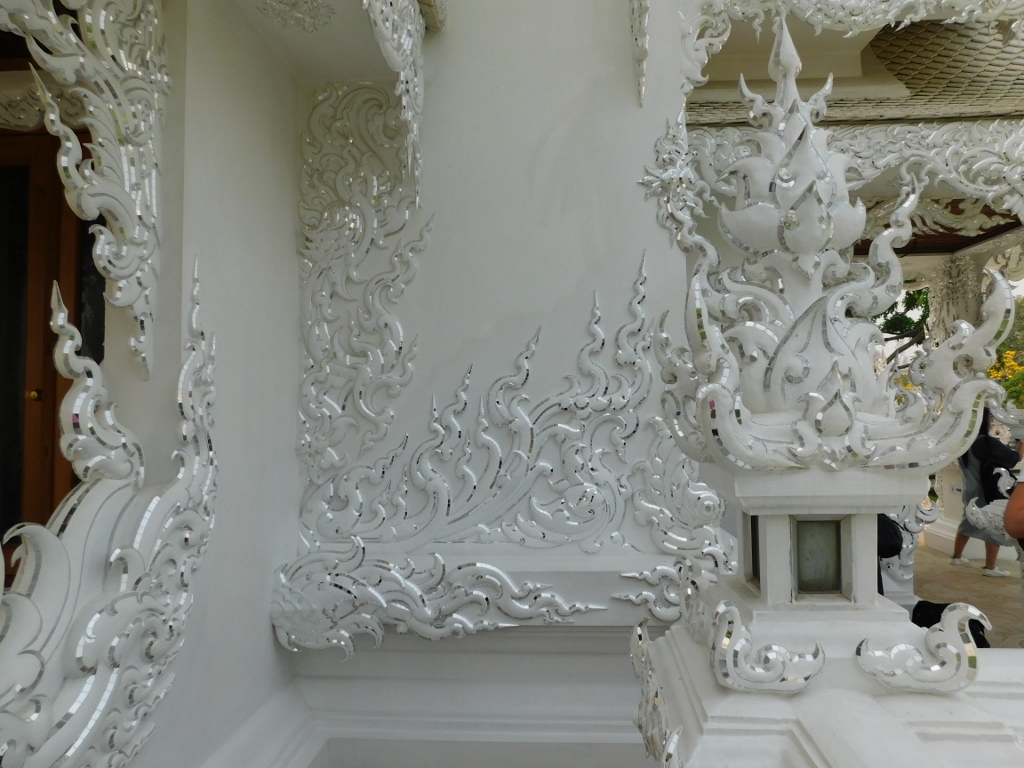 Wat Rong Khun, the ubosot, a detail
Wat Rong Khun, the ubosot, a detail
And from the end of this second structure, the final part of the temple complex unfolds, where new buildings are yet to be richly adorned. In addition to the whiteness, everything exudes harmony as well.
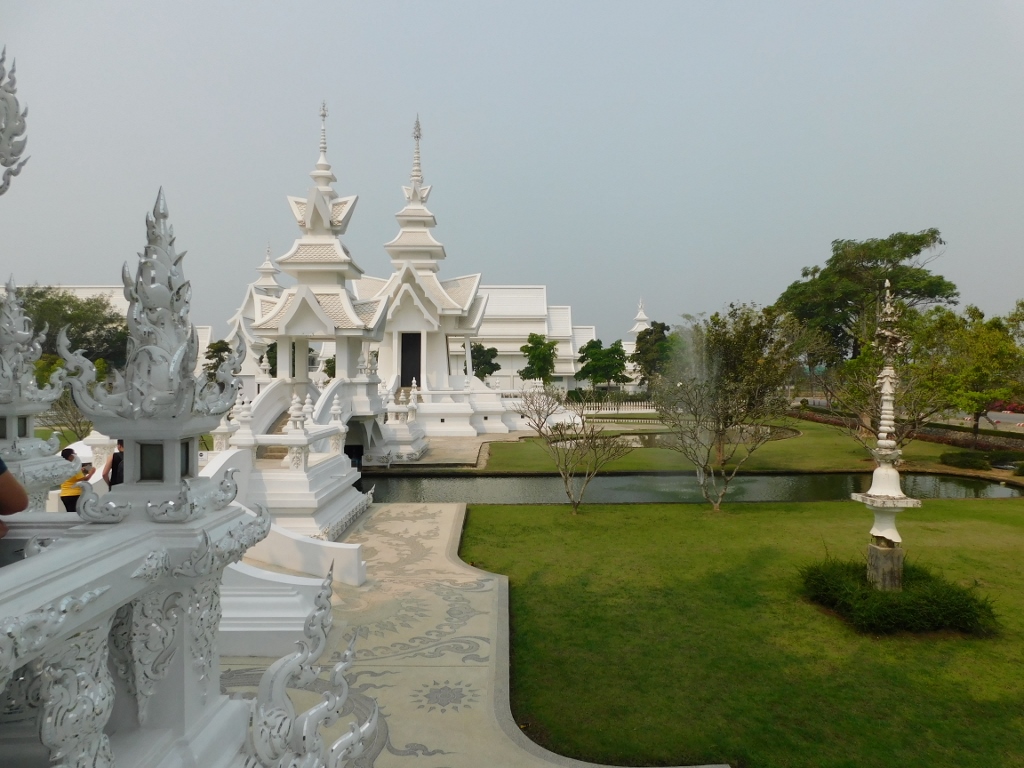 Wat Rong Khun, a detail
Wat Rong Khun, a detail
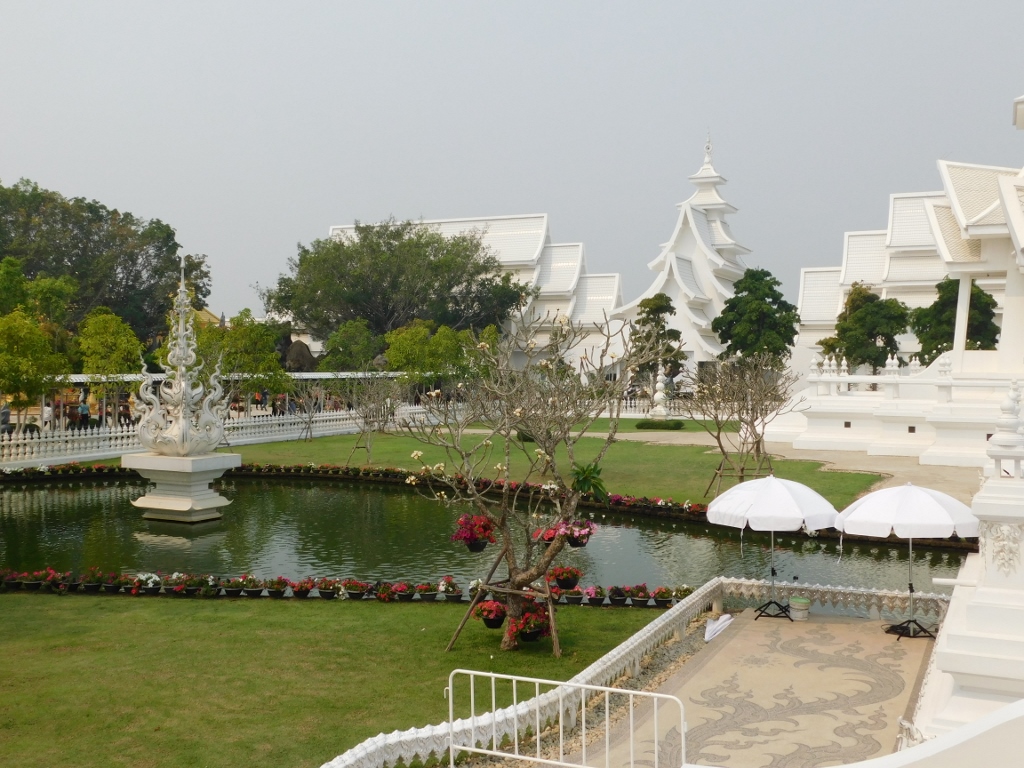 Wat Rong Khun, a detail
Wat Rong Khun, a detail
The decorations extend not only to the facades, but also to some beautifully crafted pathways. On the other hand, as can be seen in the photo below, here, the areas accessible to the public are clearly marked, distinguishing them from the restricted ones.
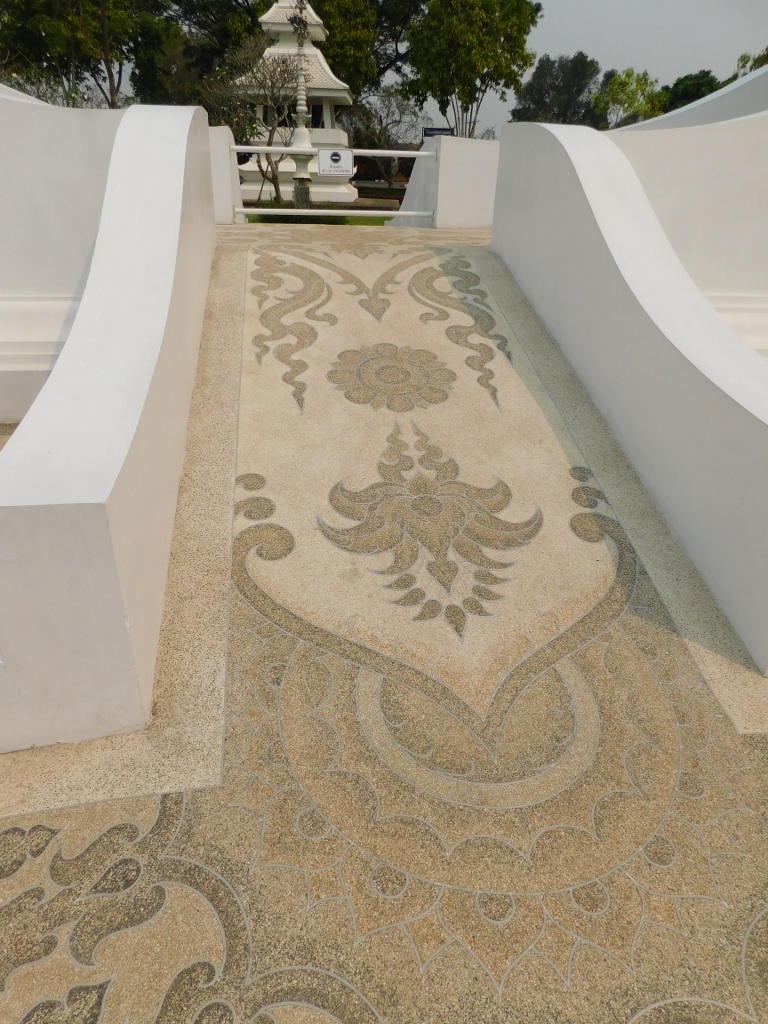 Wat Rong Khun, the ubosot, a detail
Wat Rong Khun, the ubosot, a detail
By the way, when I looked at some photos on the internet after returning home, I could clearly see to what extent this temple is an evolving work of art. I don’t know when those specific photos I saw online were taken, but there are neither external decorations on the structure behind the ubosot nor the low fence seen in the following picture. Who knows how much will be added by the time I publish this text.
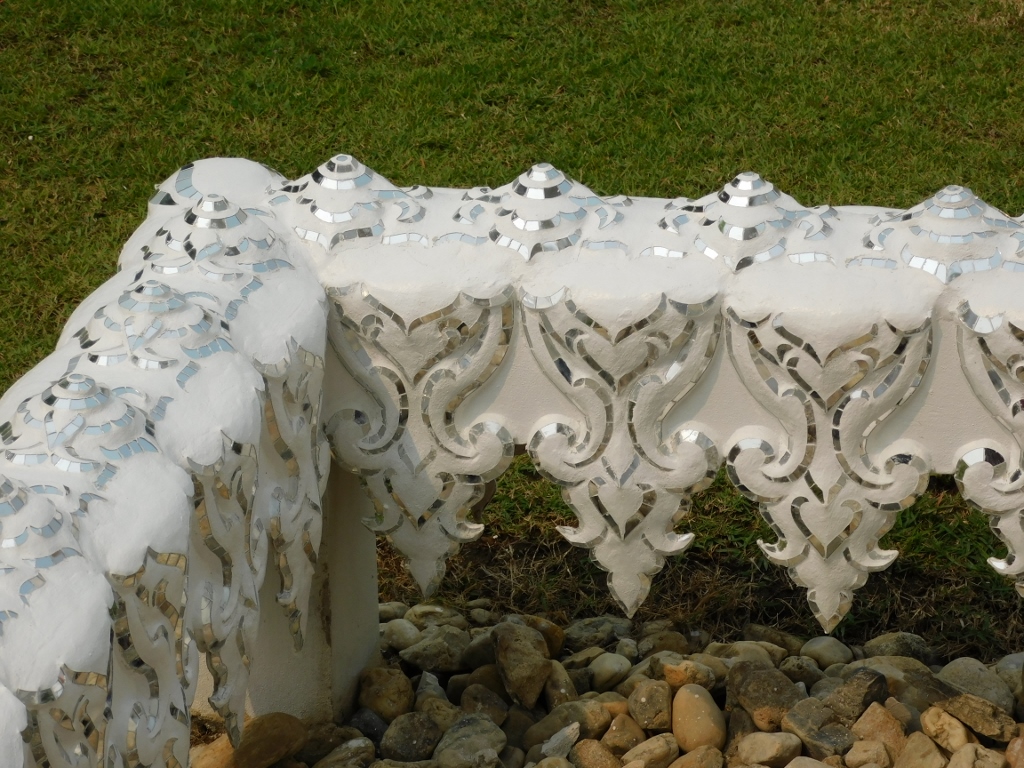 Wat Rong Khun, the ubosot, a detail
Wat Rong Khun, the ubosot, a detail
Be as it may, in early March 2023, Wat Rong Khun looked as seen in the next picture. At least its main parts...
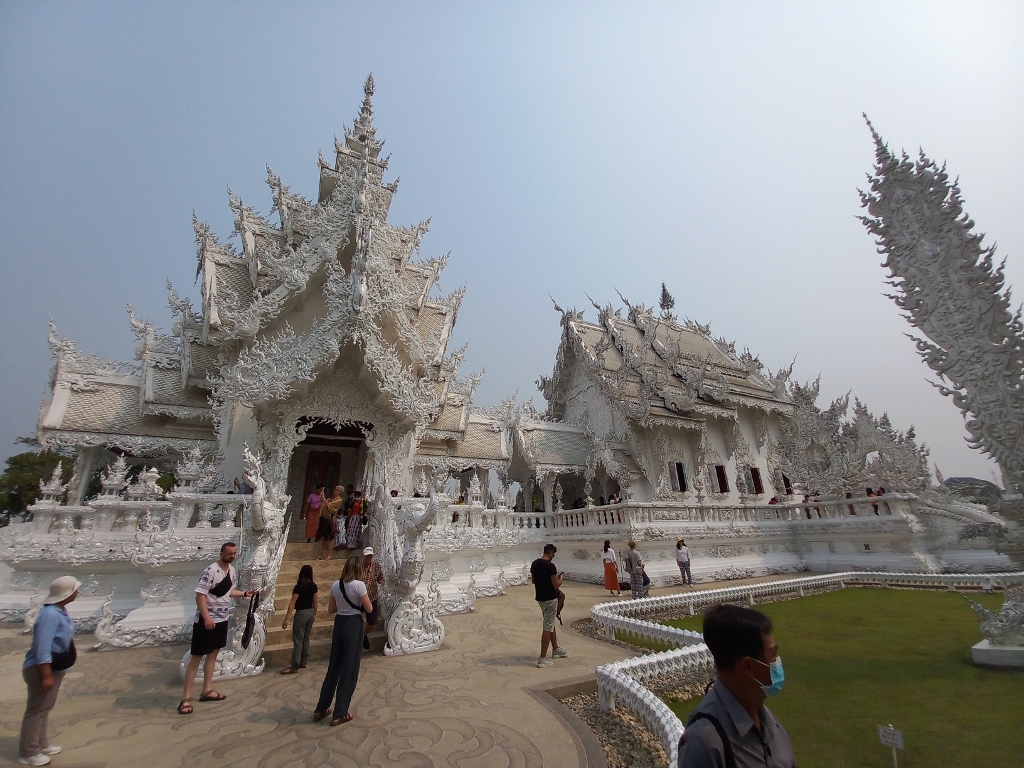 Wat Rong Khun, the ubosot
Wat Rong Khun, the ubosot
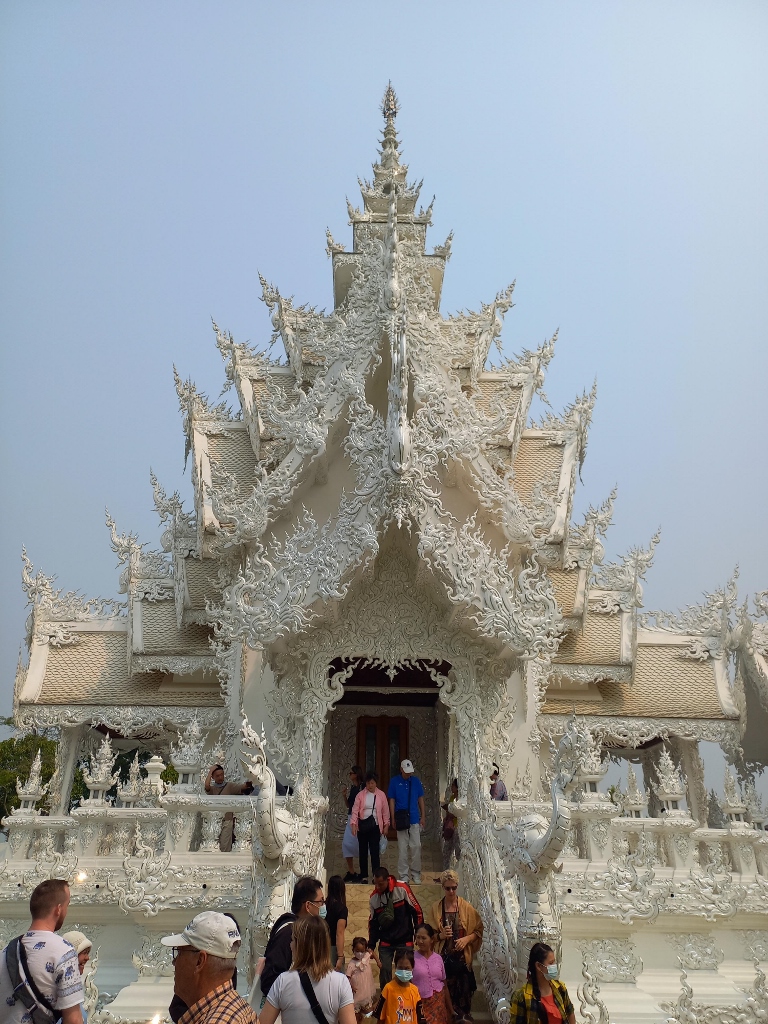 Wat Rong Khun, a detail
Wat Rong Khun, a detail
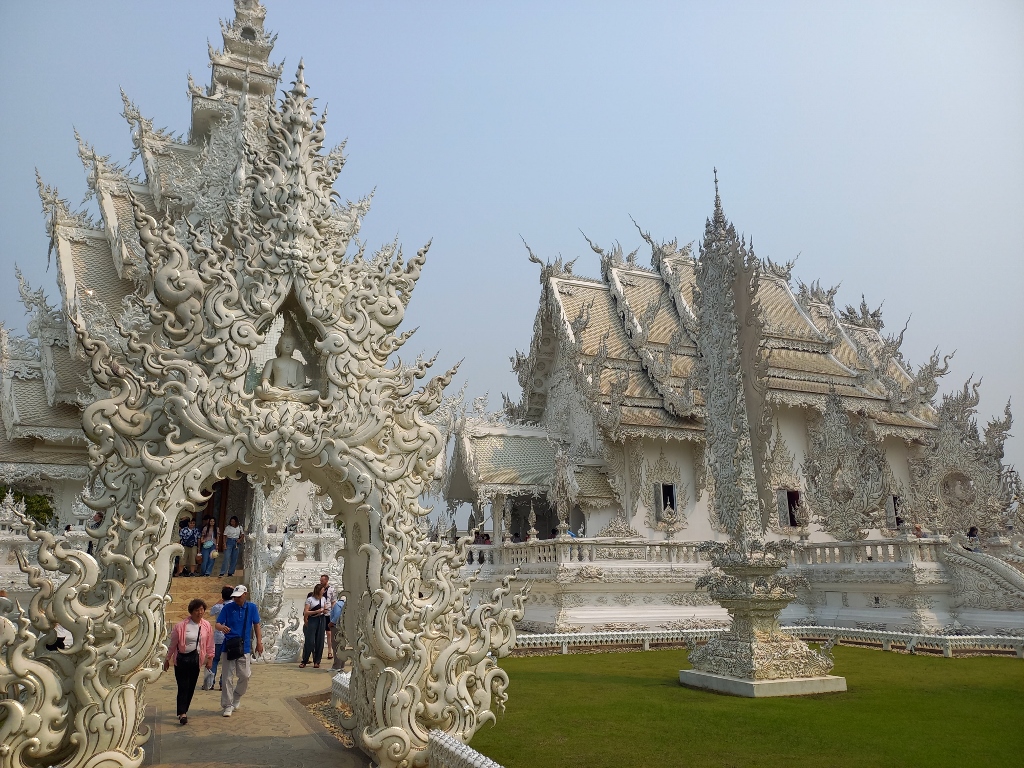 Wat Rong Khun, a detail
Wat Rong Khun, a detail
Now, I headed along a covered pathway towards the rear parts of the temple complex and what caught my attention was precisely that canopy covered with closely fixed metal “leaves” typically used when leaving names or wishes of the visitors. Here, I assume it’s another artistic detail.
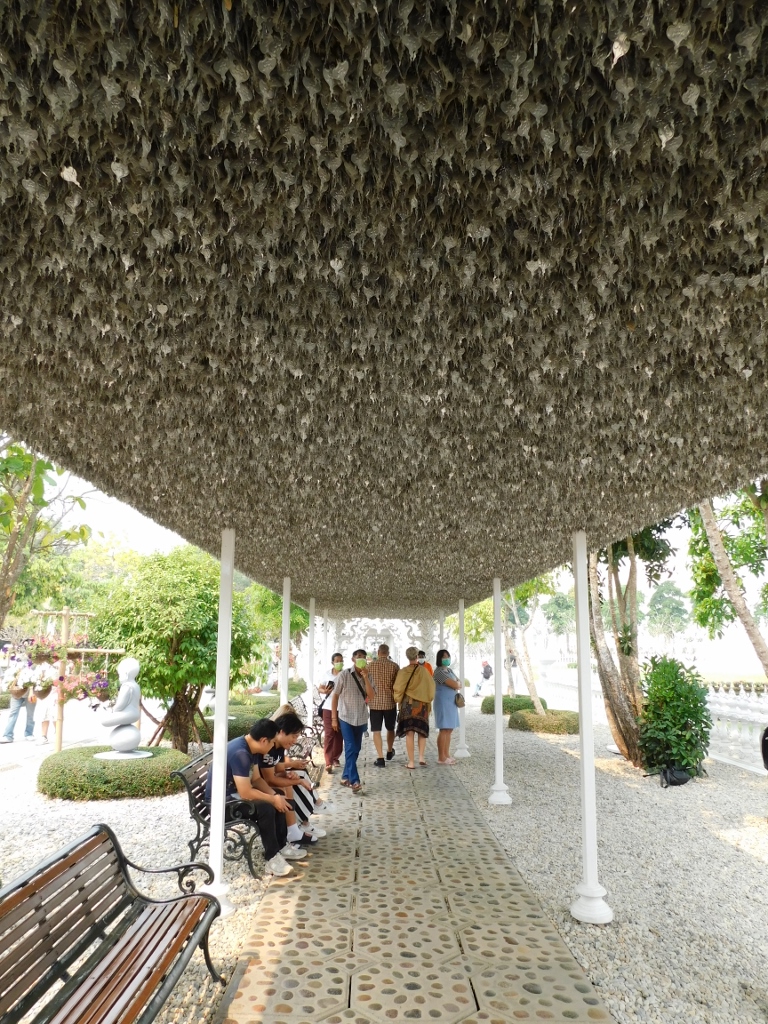 Wat Rong Khun, a detail
Wat Rong Khun, a detail
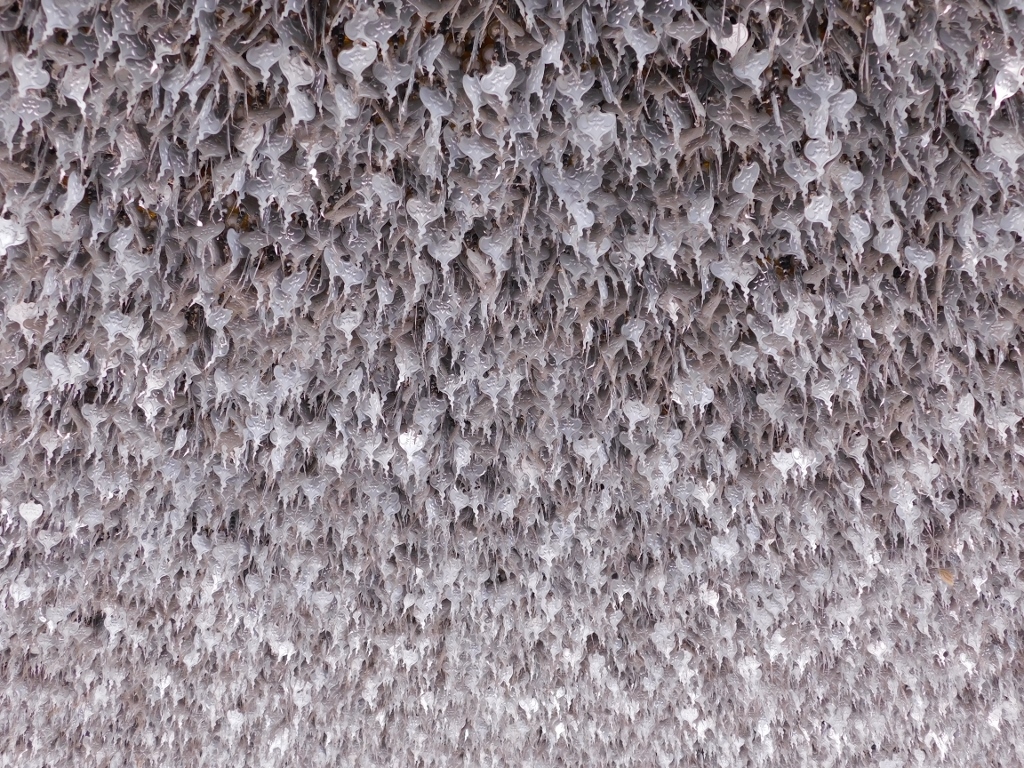 Wat Rong Khun, a detail
Wat Rong Khun, a detail
Yet, even from this angle, the ubosot looked like something out of a fairy tale.
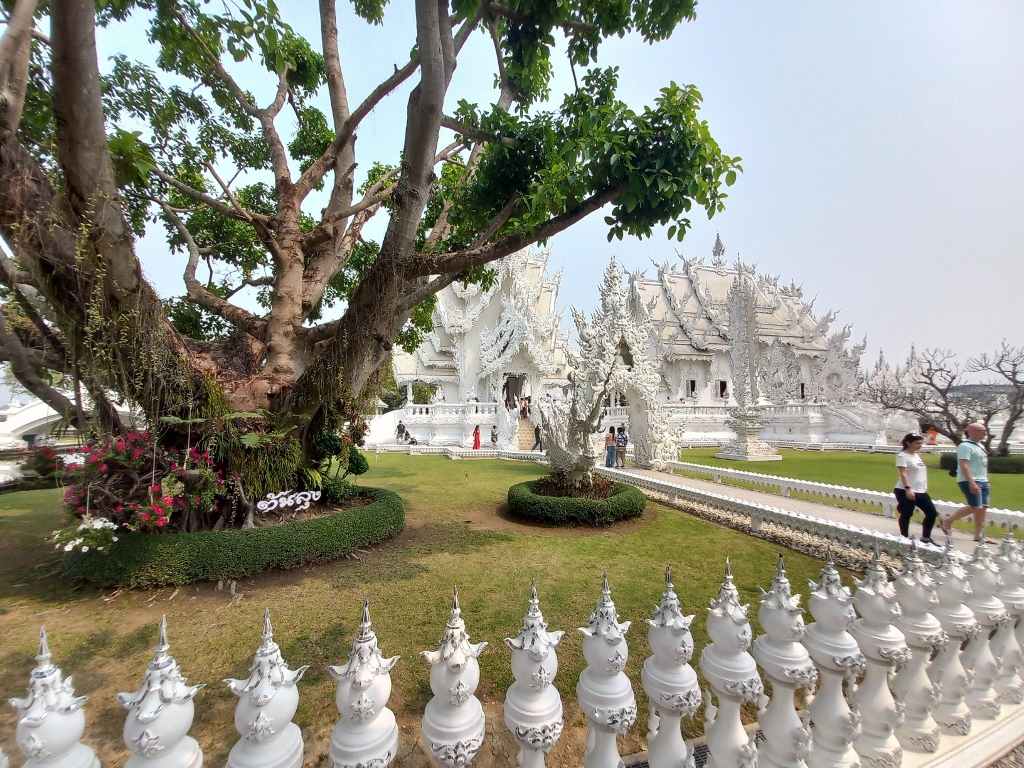 Wat Rong Khun, a detail
Wat Rong Khun, a detail
On the other hand, it can be seen that the structures extending in a series behind the ubosot and after the bridge are not yet richly adorned. As I’ve mentioned before, from what I gathered by looking at “historical” photos, this represents the first phase of building the structure, followed by the decorating with forms and fragments of mirrors.
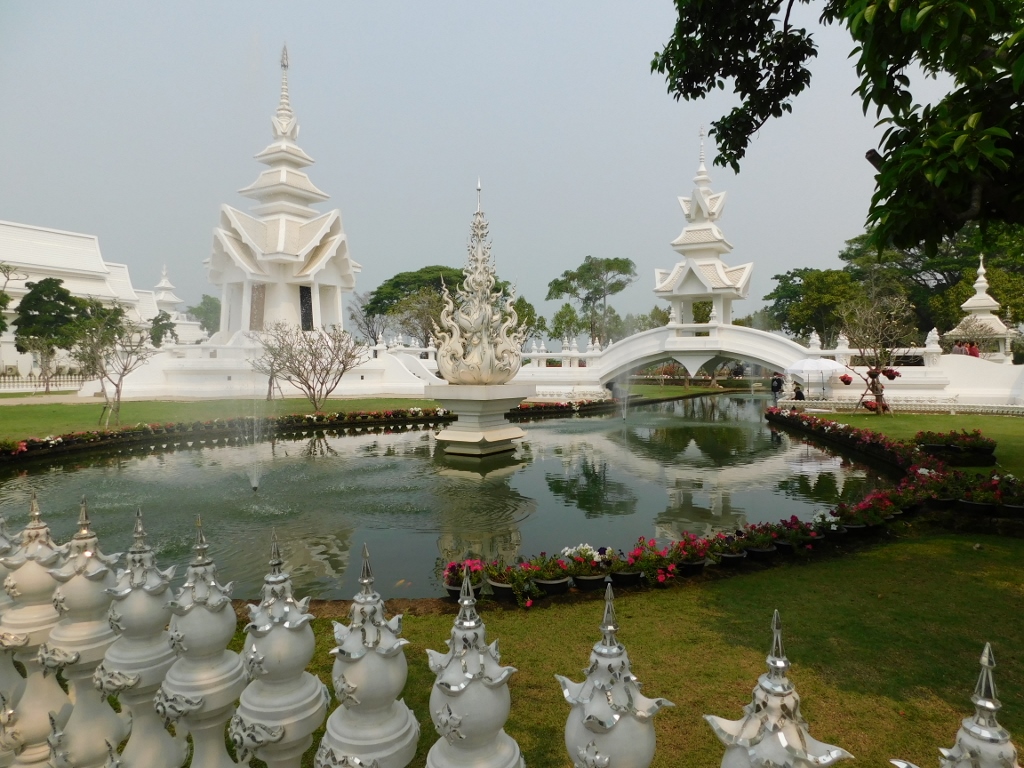 Wat Rong Khun, a detail
Wat Rong Khun, a detail
When I reached this part, I once again turned back to look at the ubosot and the pond behind it. I probably went overboard with photographing the same object, but I was genuinely impressed.
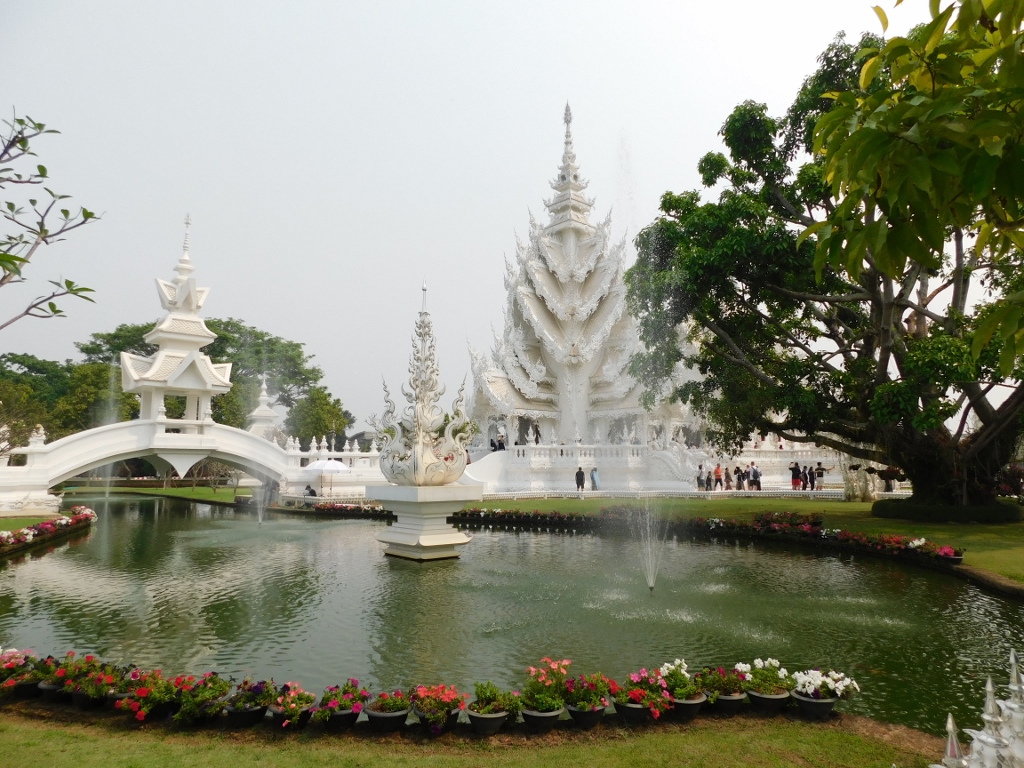 Wat Rong Khun, a detail
Wat Rong Khun, a detail
Here, I came across one of the many interesting figures that can be seen throughout the temple complex. Even inside the ubosot, there are wall paintings featuring real or fictional, mostly cinematic, characters from contemporary Western culture, but it all follows a clear artistic and spiritual “logic.” I didn’t delve too deeply into that, opting to simply observe my surroundings. Unlike the interior of the ubosot, I was allowed to take photographs here.
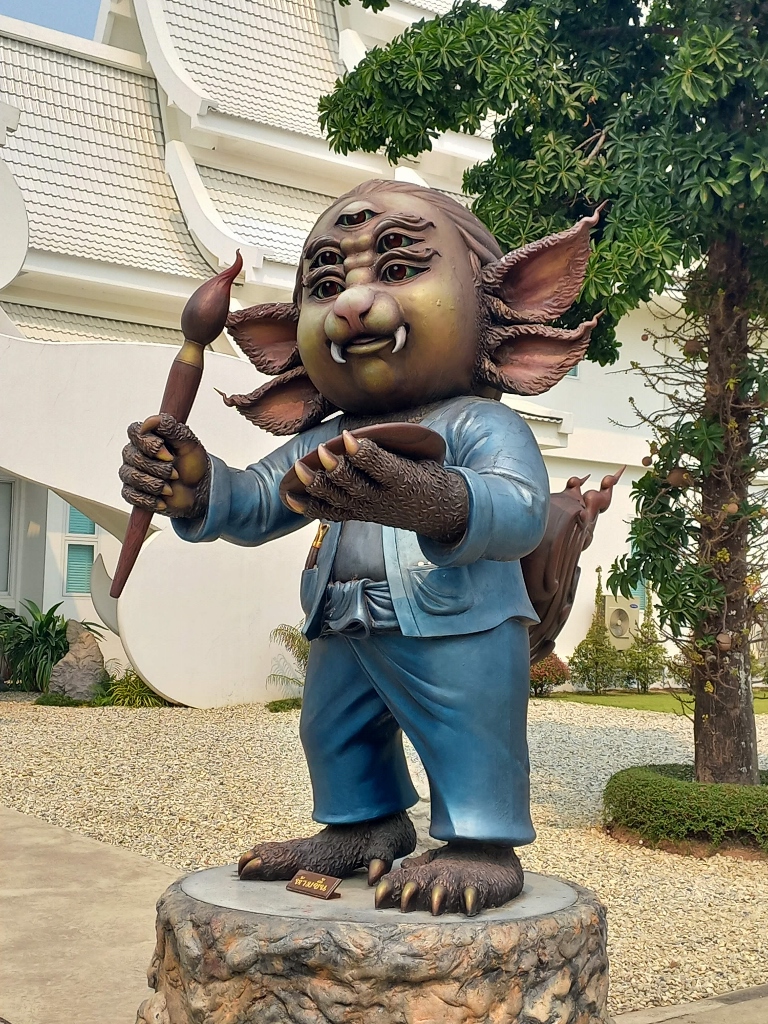 Wat Rong Khun, a detail
Wat Rong Khun, a detail
Not far from this figure, there is a place where visitors can take photos, adding to the impression that this is some kind of an amusement park.
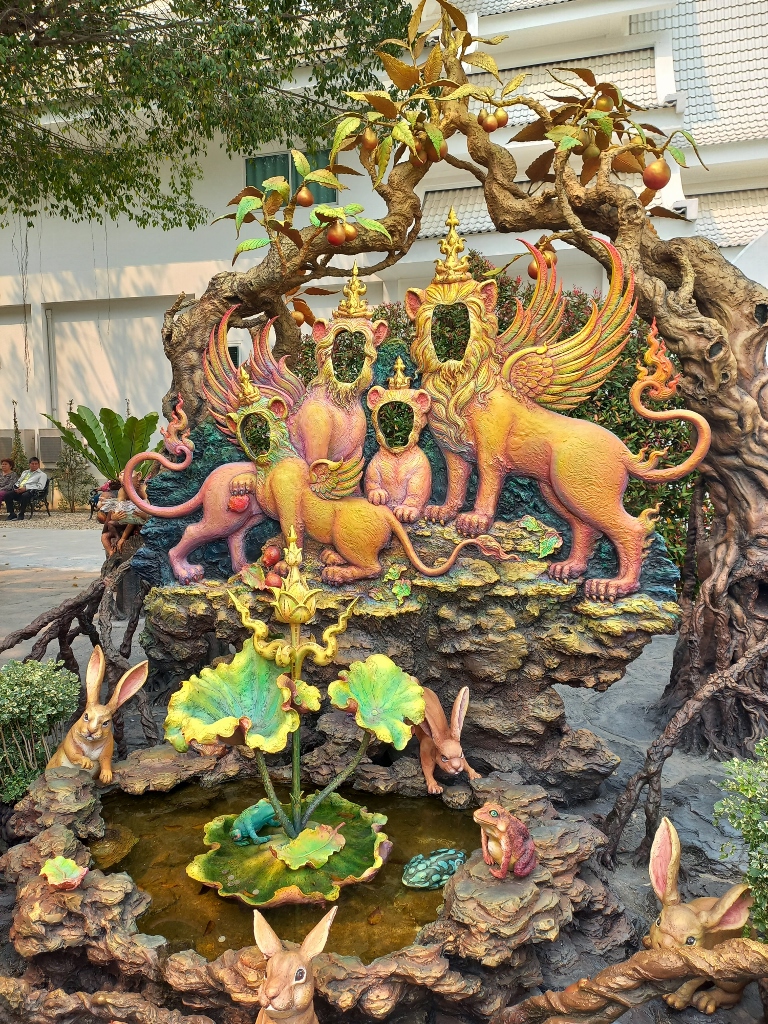 Wat Rong Khun, a detail
Wat Rong Khun, a detail
After that, you can see a section with an artificial rock, waterfalls and a pond, all filled with phantasmagorical and/or mythological beings, as well as entirely profane figures.
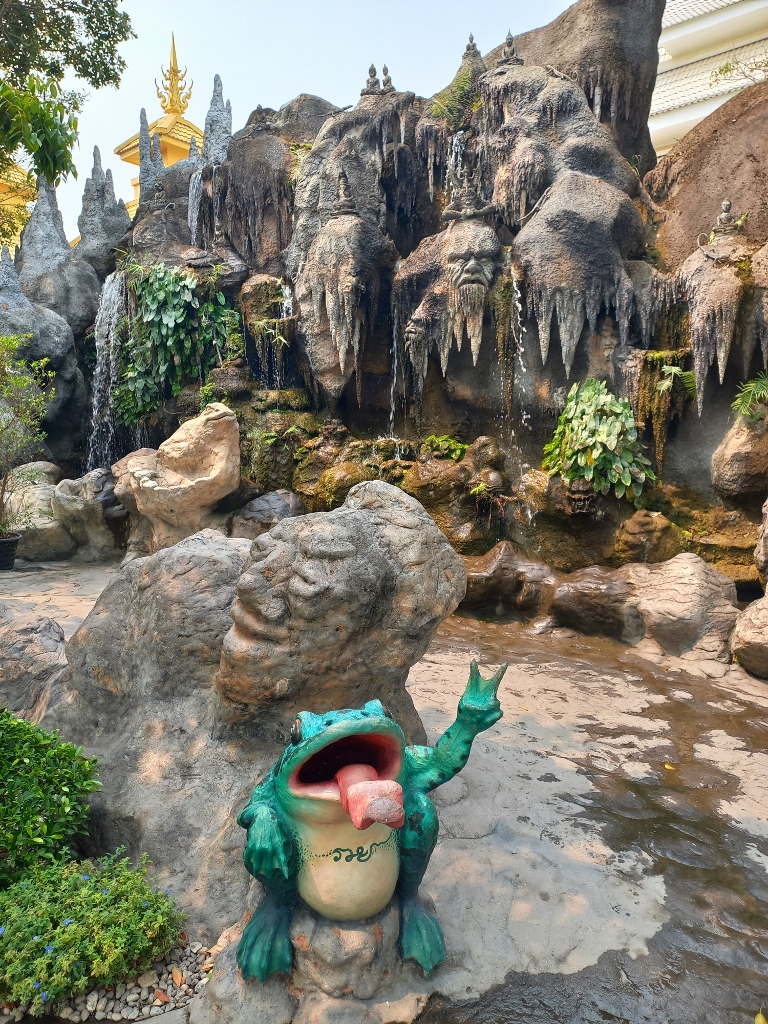 Wat Rong Khun, a detail
Wat Rong Khun, a detail
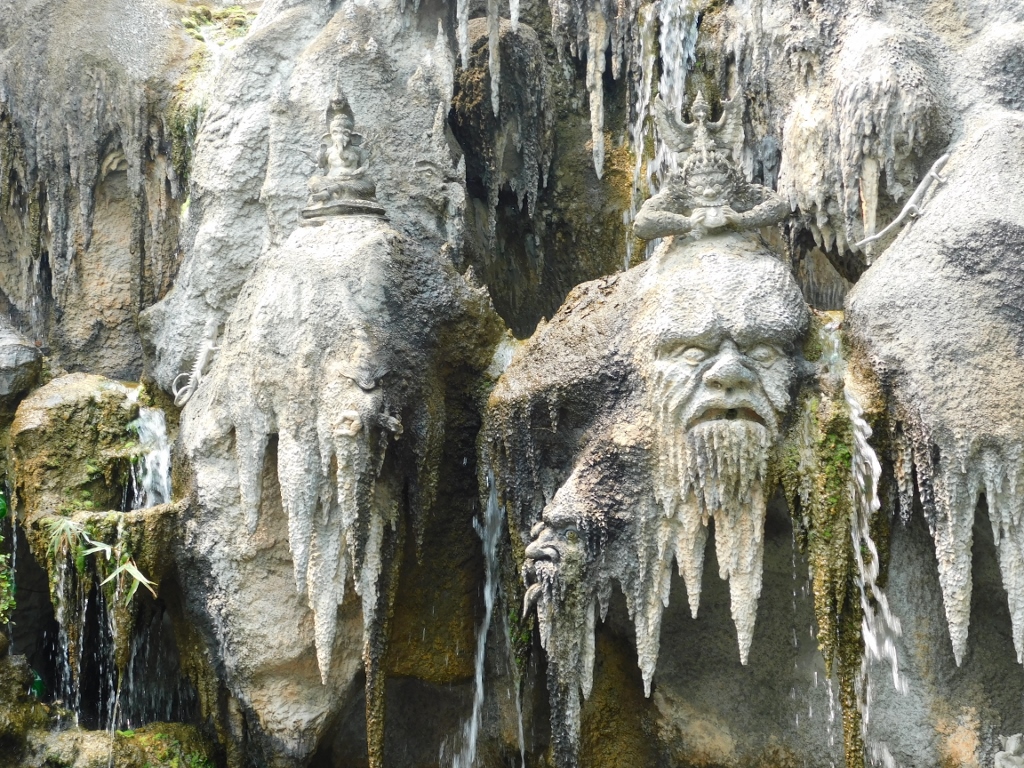 Wat Rong Khun, a detail
Wat Rong Khun, a detail
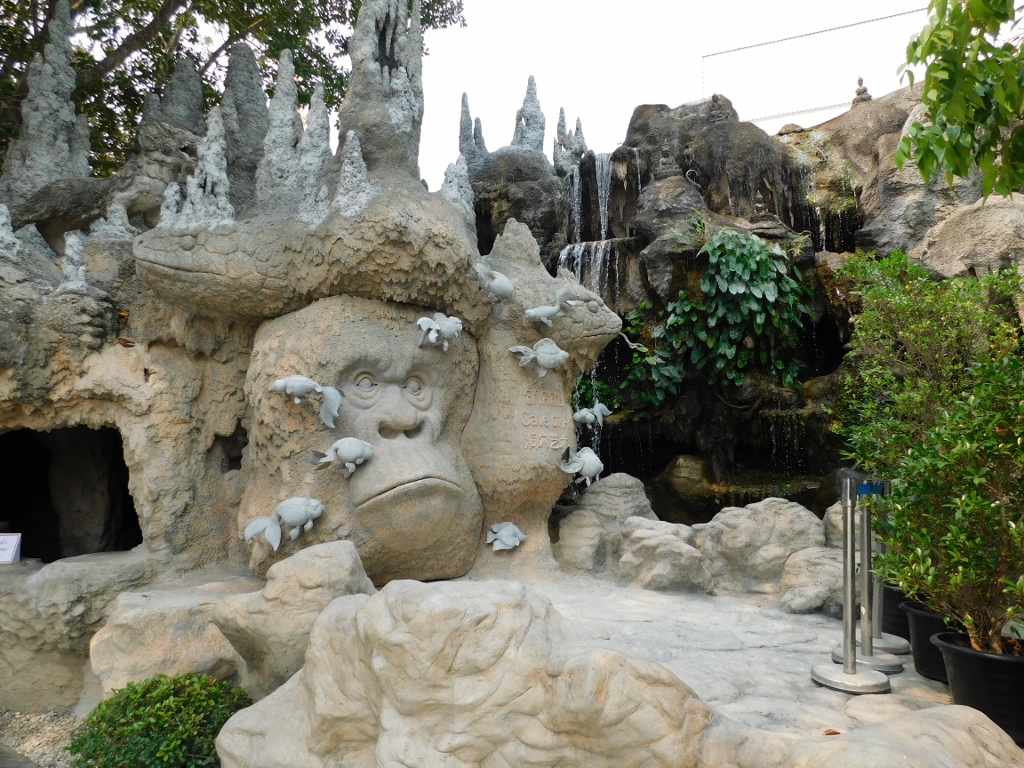 Wat Rong Khun, a detail
Wat Rong Khun, a detail
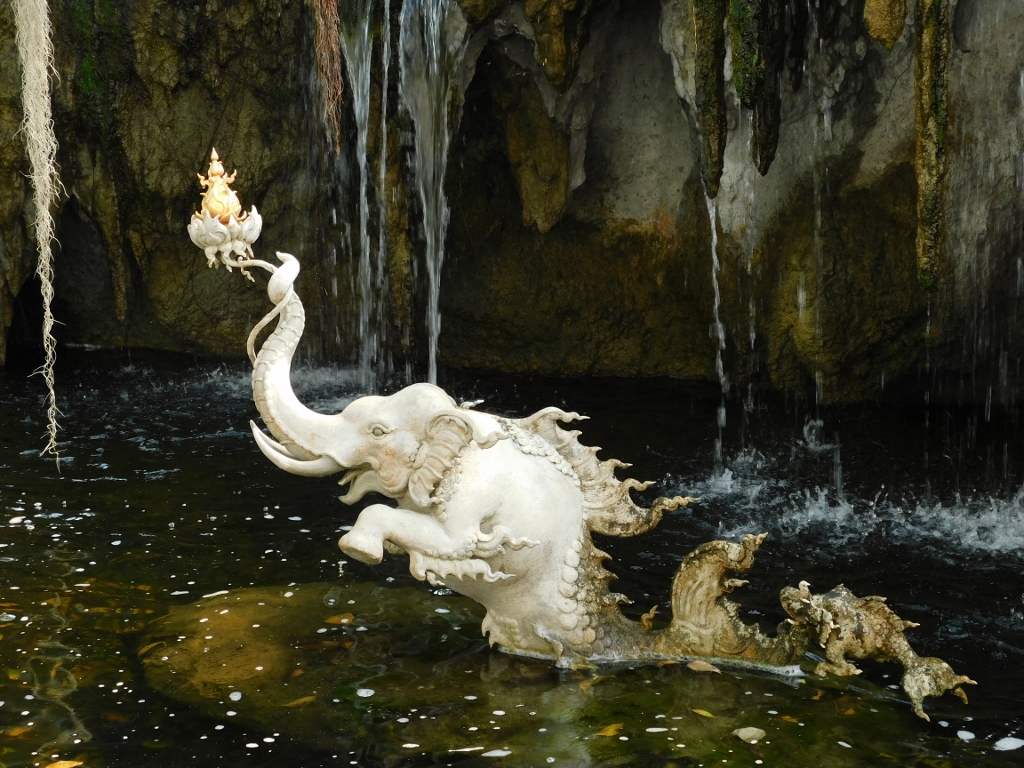 Wat Rong Khun, a detail
Wat Rong Khun, a detail
However, to ensure that visitors don’t forget they are in a temple, in other words a religious complex, right next to it, there is a serene “oasis” with a Buddha figure.
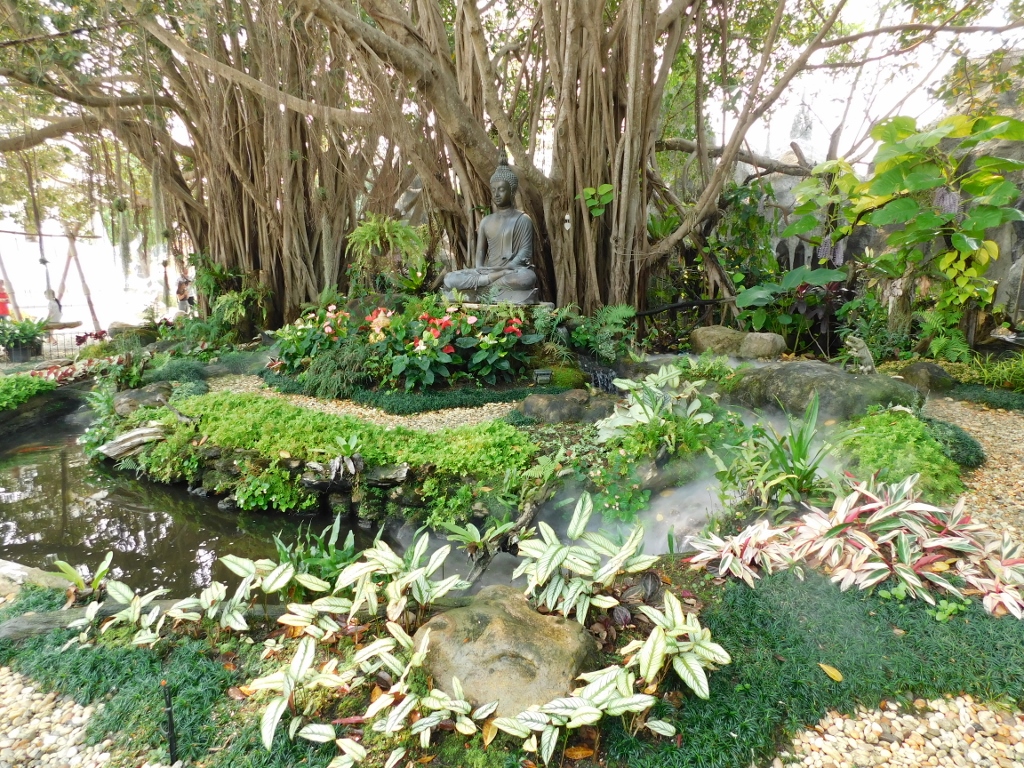 Wat Rong Khun, a detail
Wat Rong Khun, a detail
The previous pictures depict details from the temple complex around a spacious plaza, in the centre of which there is a bell. Like everything else in this temple, the structure supporting the bell is not simple; it is exceptionally richly adorned.
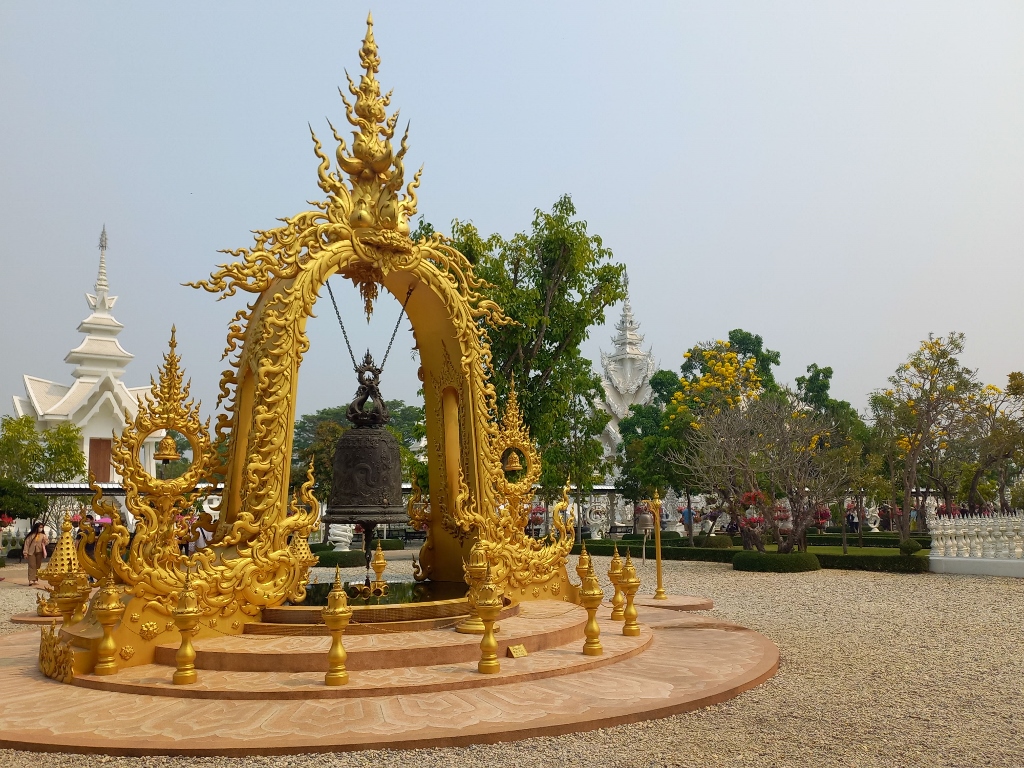 Wat Rong Khun, a detail
Wat Rong Khun, a detail
Since I visited Wat Rong Khun with a group, I had limited time for the visit, so now I had to hurry a bit. Thus, I went south of the main temple area and there I saw the Golden Temple.
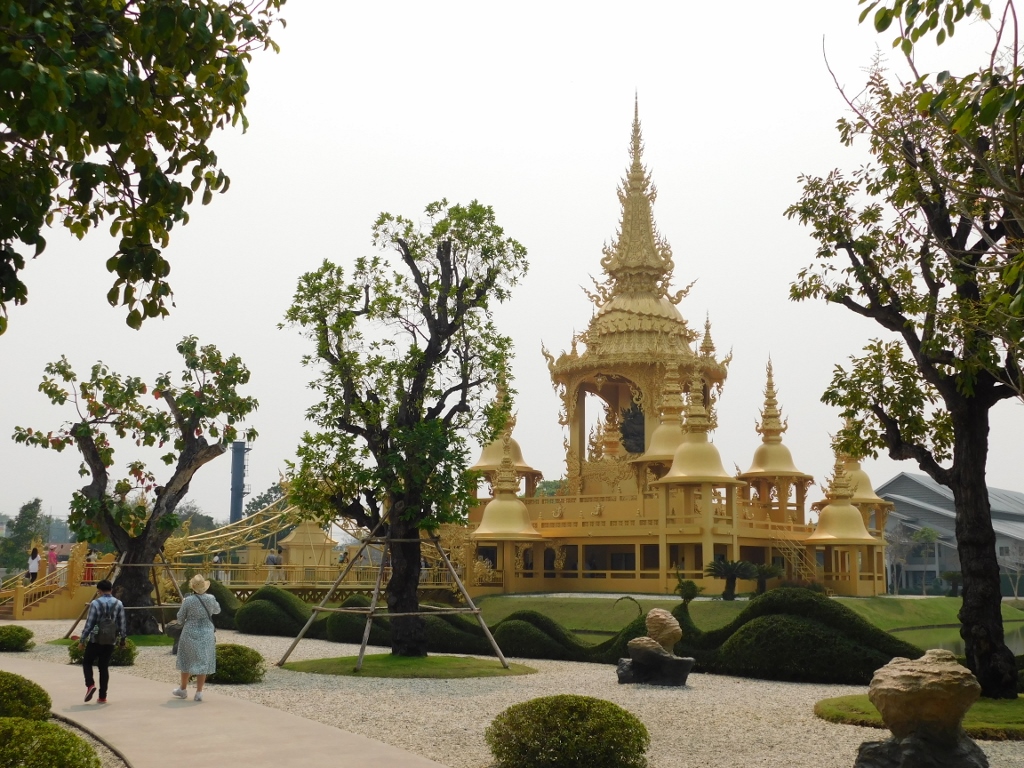 Golden Temple
Golden Temple
This temple is situated on a square-shaped islet in the middle of a tranquil pond. The “island” is connected to the mainland by a causeway from the front, but there is also a bridge built on the side that is mostly used for the access to the temple, while everything is painted in a golden hue. I managed to see that there is a statue of Ganesha, a Hindu deity, in the central part, but I couldn’t find any other information. The temple can be visited as part of the White Temple tour, but I didn’t have the time for that.
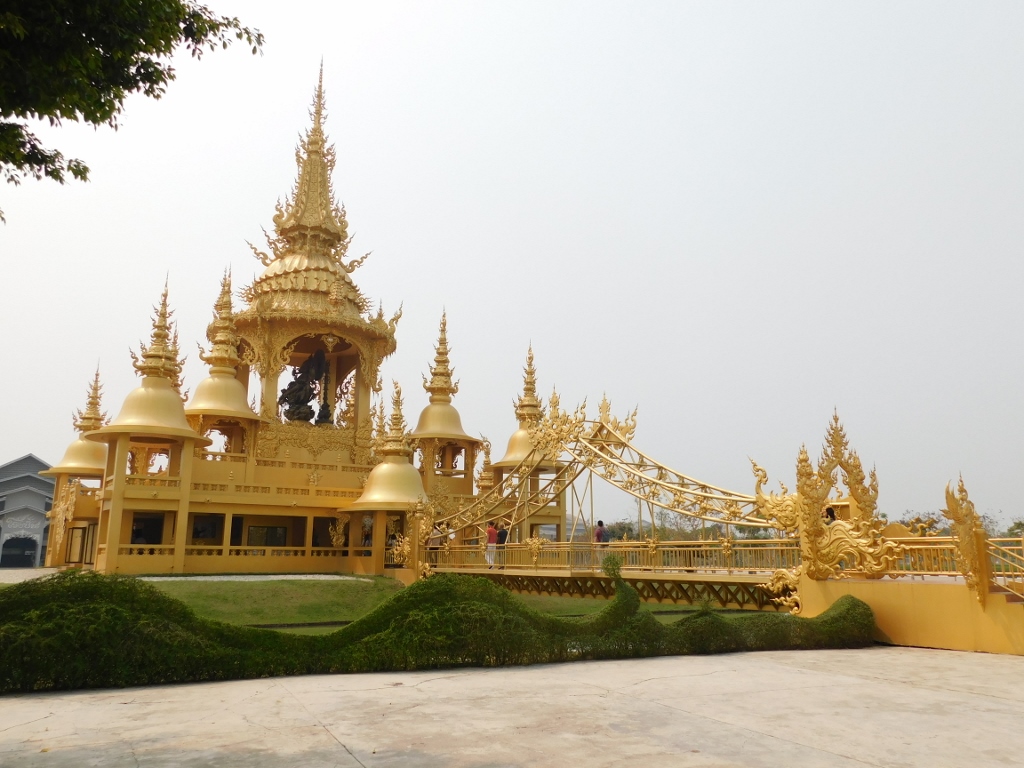 Golden Temple
Golden Temple
So, I just turned around and headed towards the central part of the temple complex. Even here, on the periphery of the temple, one structure is completely finished, at least from the outside, and richly decorated.
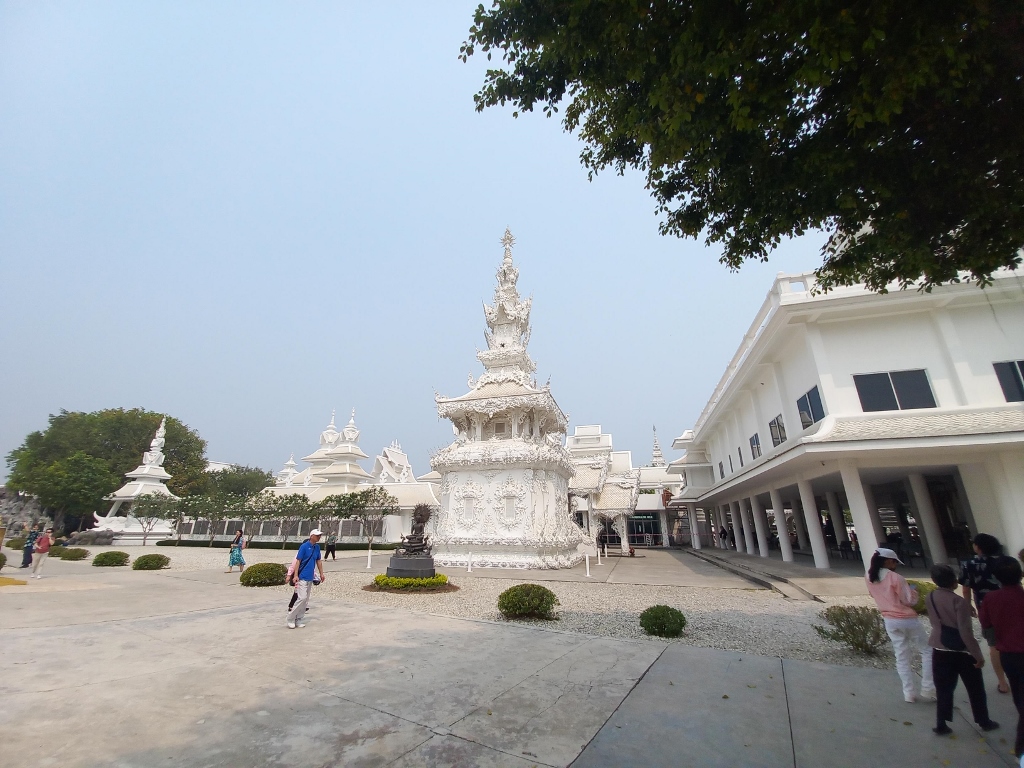 Wat Rong Khun, a detail
Wat Rong Khun, a detail
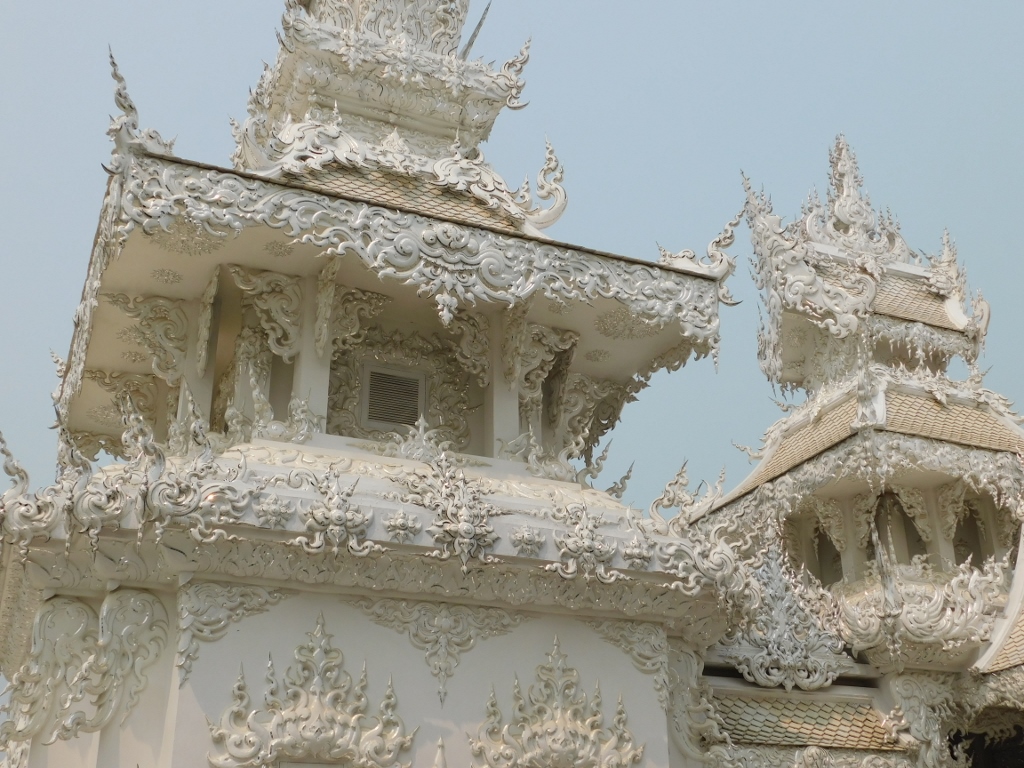 Wat Rong Khun, a detail
Wat Rong Khun, a detail
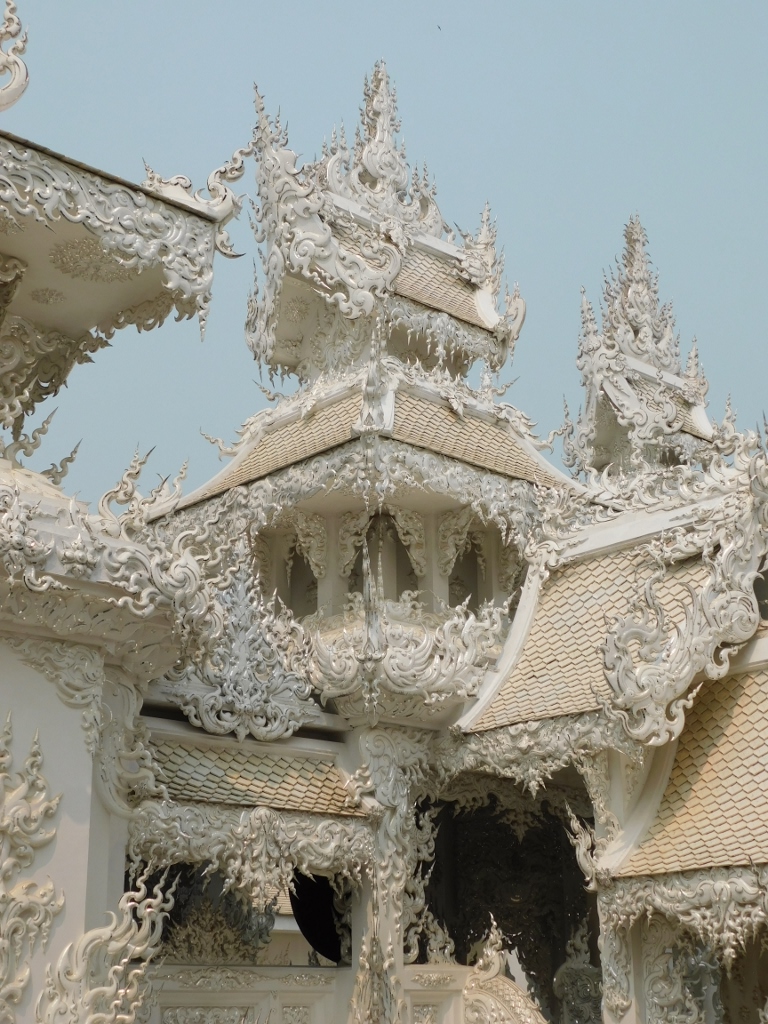 Wat Rong Khun, a detail
Wat Rong Khun, a detail
Near the central path, on a clearing, there are several structures resembling Christmas trees, but made of those metal sheet leaves. In addition to them, in this area, there is an interesting smaller structure with a round plan featuring a semi-spherical dome.
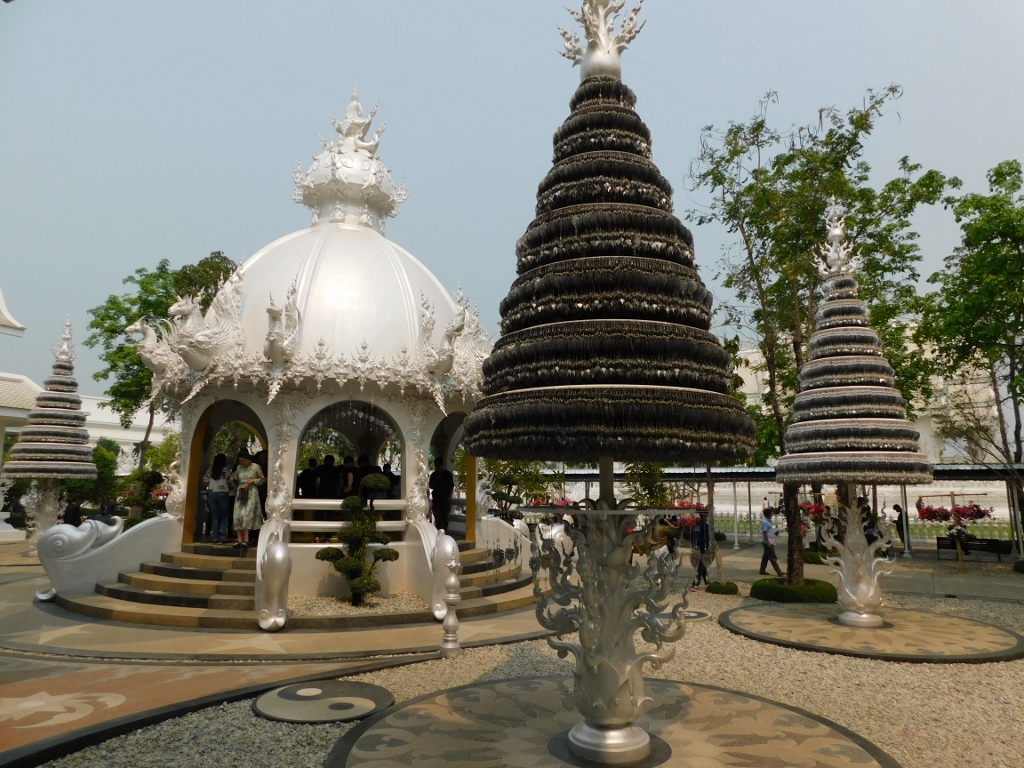 Wat Rong Khun, a detail
Wat Rong Khun, a detail
When I climbed up there, in the middle, I saw something resembling a wishing well, with a note that some of the decorative elements here were drawings of Western zodiac signs.
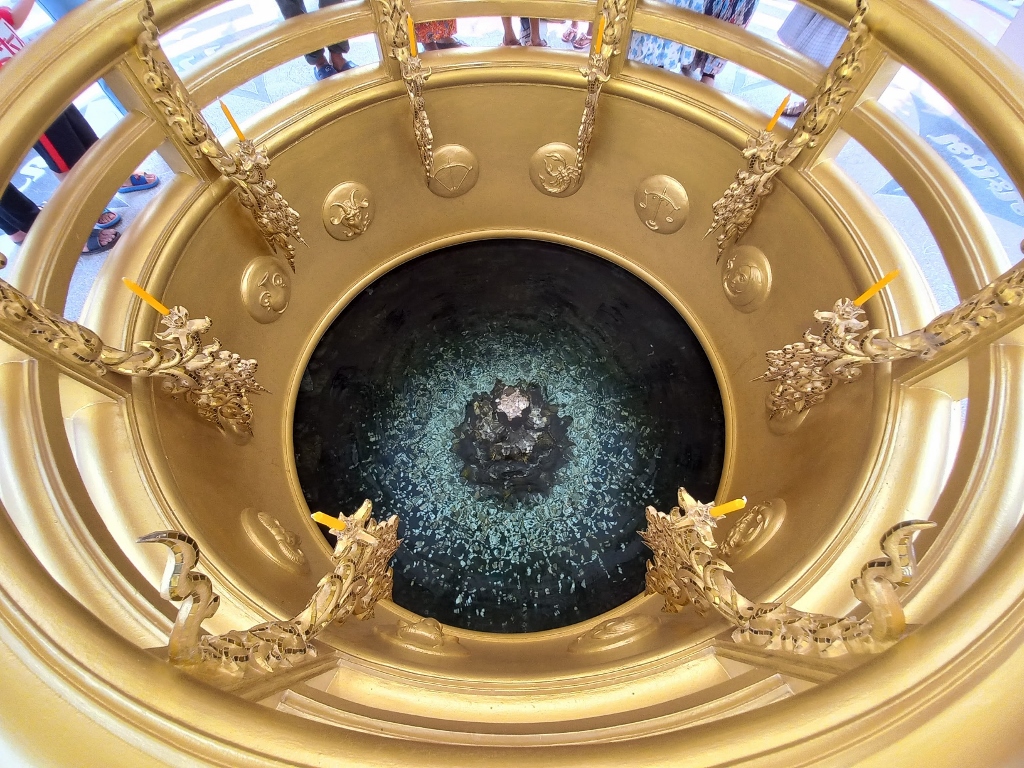 Wat Rong Khun, a detail
Wat Rong Khun, a detail
All of this was exceptionally interesting, but the intriguing and picturesque details didn’t end here. In the central part of the temple complex, there is a golden building that, at least on the ground floor, serves as a toilet. It is probably the most eccentric public toilet in the world.
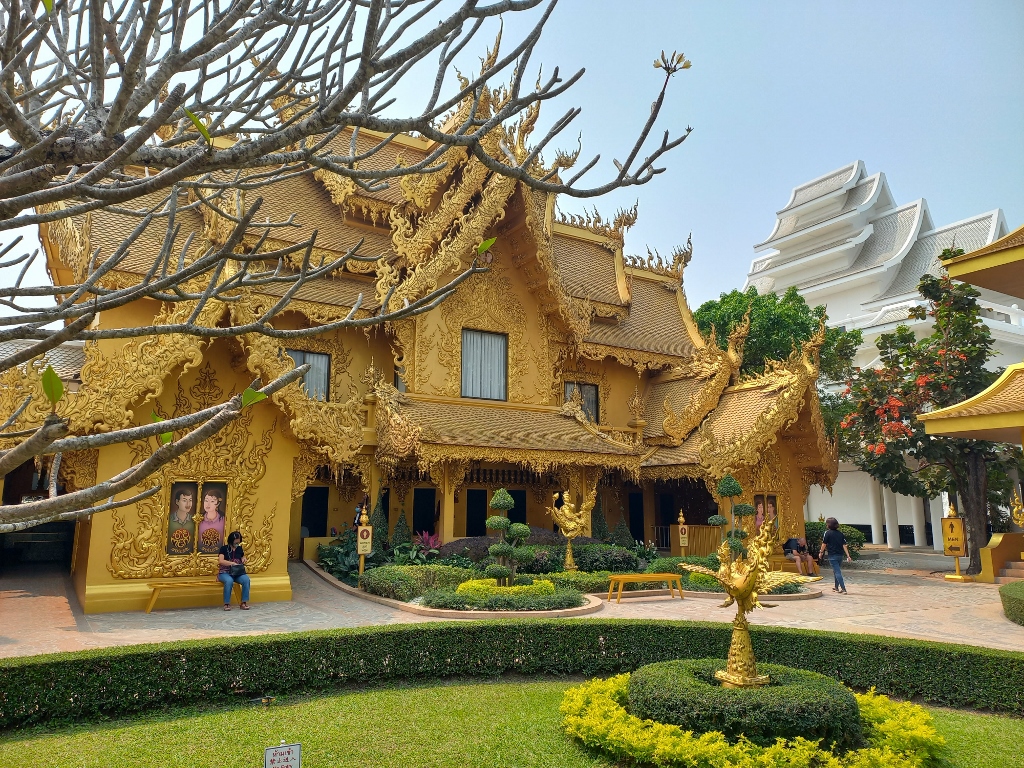 Wat Rong Khun, toilet building
Wat Rong Khun, toilet building
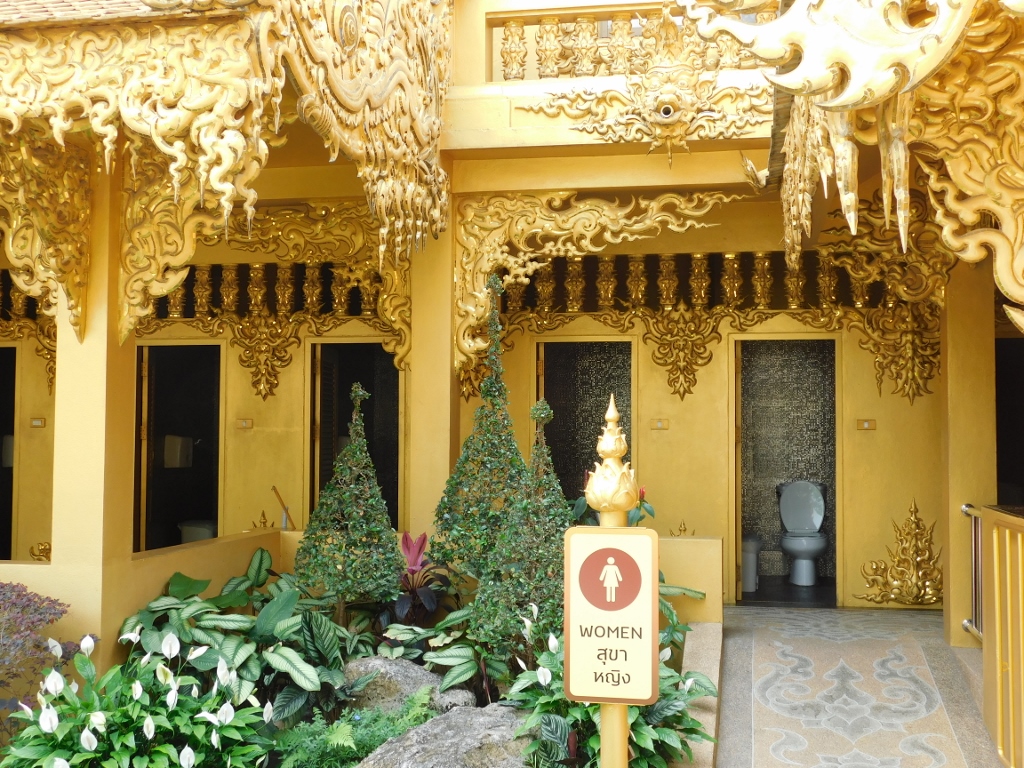 Wat Rong Khun, toilet building
Wat Rong Khun, toilet building
Still, what is fascinating is that this wasn’t done randomly. In fact, this golden building represents the body, as gold symbolises human focus on money, possessions and hence constant and unrestrained desires. On the other hand, precisely opposite to it, in relation to the central path, there is the white ubosot representing the mind, while its whiteness reminds us to focus on the mind itself, not on material things. It encourages us to strive for achieving karmic virtues through moral and spiritual activities.
The hour I had here passed very quickly and I had to make my way to the place where the group I came with was supposed to gather. Along the way, I saw a bit more of those “weird” details from Western fiction. However interesting they looked, their function wasn’t entirely clear to me. This didn’t stop visitors from enjoying them, nor did it stop me from taking photos.
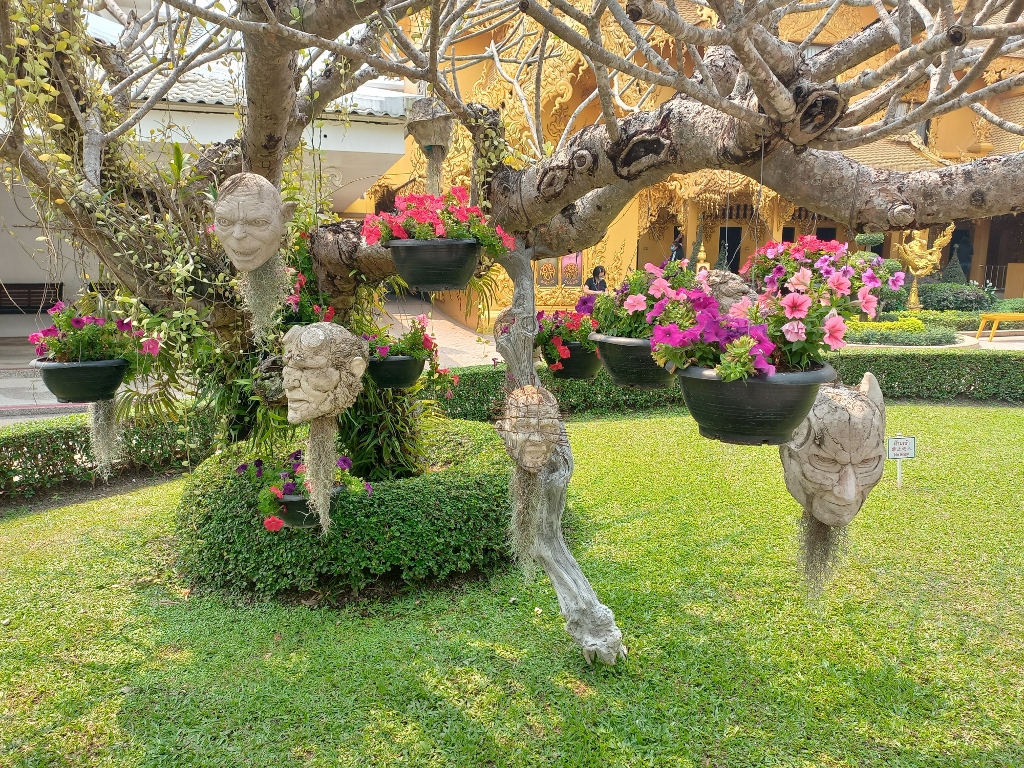 Wat Rong Khun, a detail
Wat Rong Khun, a detail
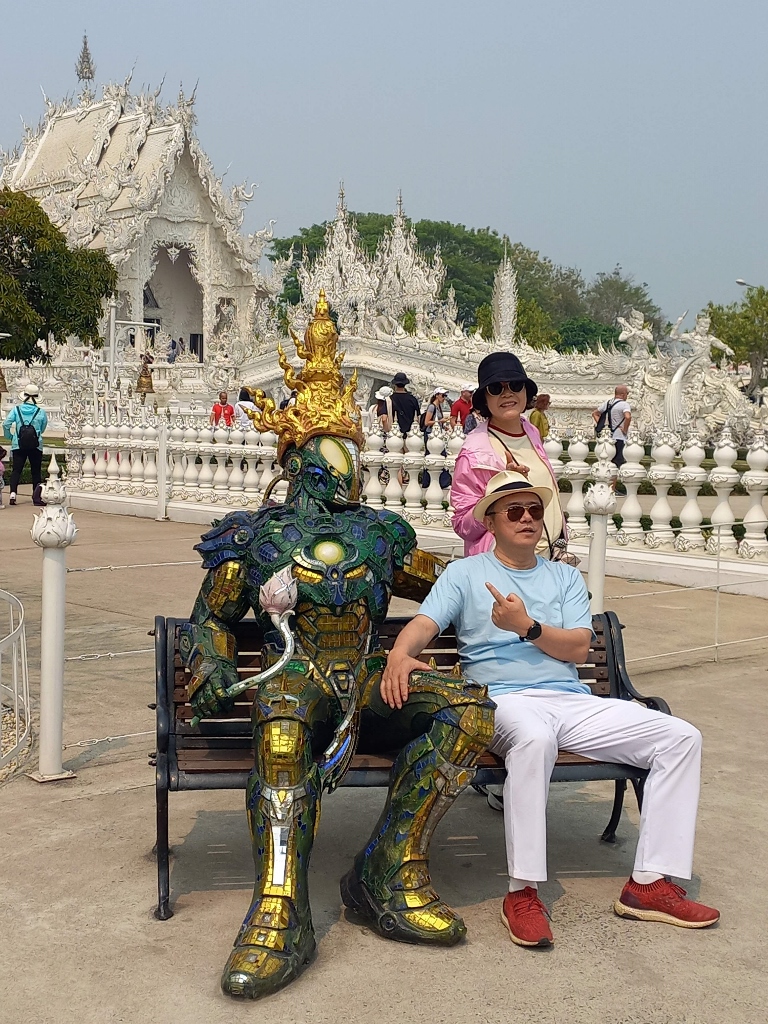 Wat Rong Khun, a detail
Wat Rong Khun, a detail
I still had time to take another look at the ubosot of Wat Rong Khun and to conclude once again how it is a truly extraordinary and exceptionally picturesque structure.
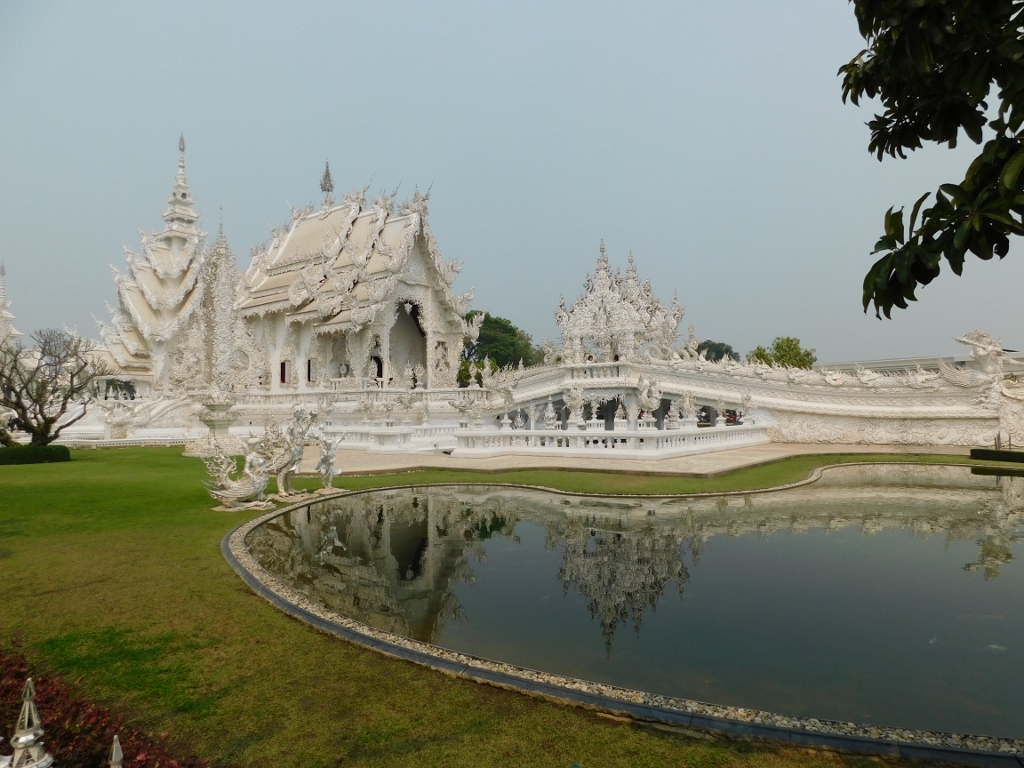 Wat Rong Khun
Wat Rong Khun
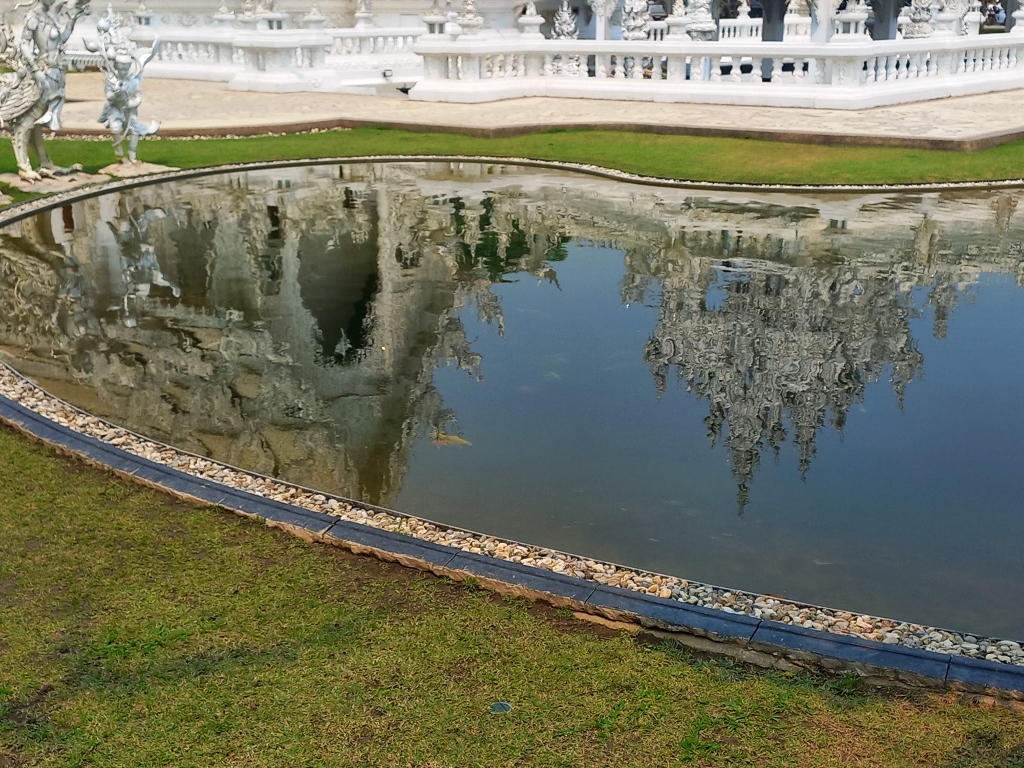 Wat Rong Khun, a detail
Wat Rong Khun, a detail
After the group gathered, we all went to have lunch since it was included in the tour price. The table was set in the middle of an area with shops and the owners of the “restaurant” or “kitchen” brought our food there.
I wasn’t particularly interested in shopping, so after lunch, I was eagerly anticipating getting back into the minibus and cooling down, even if only for a short while. Although I had to wait a bit, we soon set off and travelled around 16 km to the north, within the city of Chiang Rai itself. Now, we went to visit the Wat Rong Suea Ten temple. If the previous temple was white, this one was entirely and absolutely blue, hence its other name – the Blue Temple.